


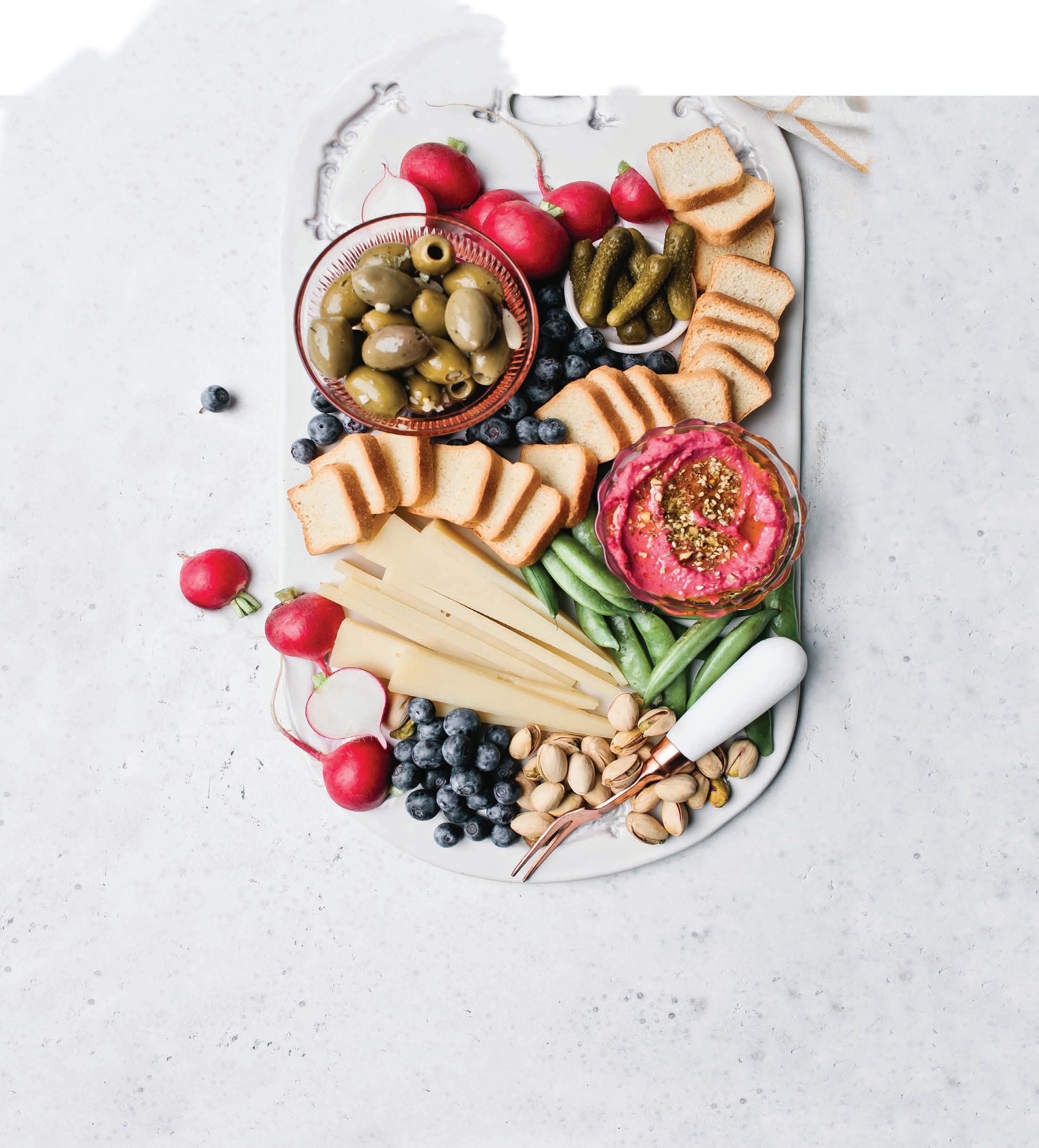



























Behold, my friends, the spring is come; the earth has gladly received the embraces of the sun, and we shall soon see the results of their love. Sitting Bull
EDIBLES by Edible Staff
DRINK LOCAL Boocharama! by Jessica Jones NOURISH Exploring Kefir by Laura Poe Mathes
FOODWAYS Seed Work is Slow Work by Jonnah Perkins
COOK AT HOME Spring Forward for Brunch by Lauren Rudersdorf
SERENDIPITY
Foraging Southern Wisconsin by Hannah Wente
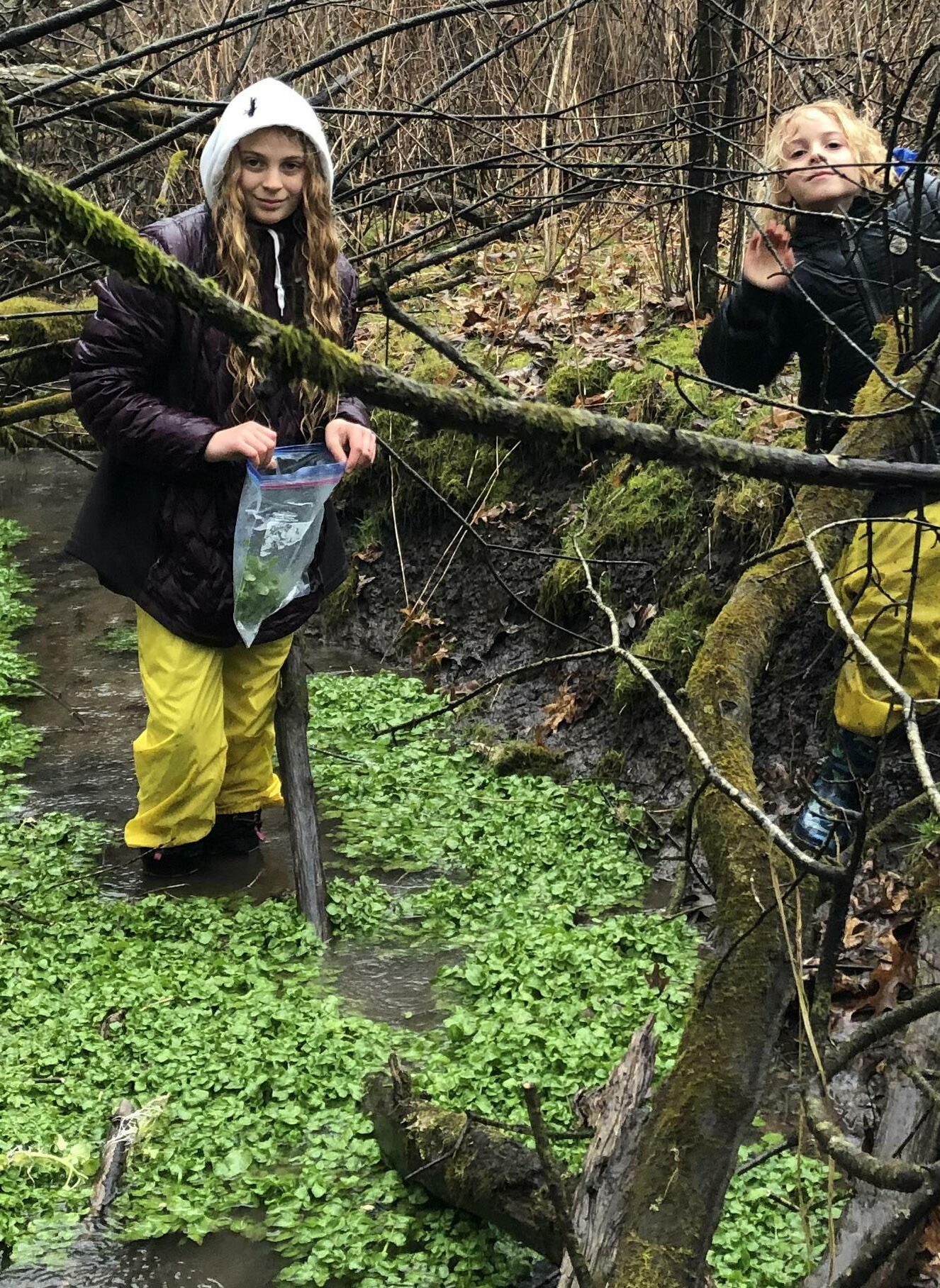
PIVOT. ADAPT. ADJUST. by Candice Wagener
LAST
by Shawn Kuhn
Sunny is an editorial and commercial photographer with a studio on the west side of Madison where she lives with her husband, their two kids and a tiny dog. She specializes in food and product photography and loves the opportunity it gives her to connect with the many wonderful businesses and entrepreneurs in Madison.
Tracy is a graphic designer and photographer from Madison, Wisconsin. A polymath at heart, she dabbles in various arenas of makery including cooking and baking, sewing and knitting, painting and collage, and has a soft spot in her heart for film photography. When she’s not busy making things, she enjoys travel, good food and drinks, gardening and live music.
Jessica Jones is the Brewer and co-owner of Giant Jones Brewing Company—an independent, women-owned, certified organic craft brewery in Madison, Wisconsin. She is a Grand Master Beer Judge through the Beer Judge Certification Program (BJCP) and an Advanced Cicerone®. Jessica loves barley wine and providing extremely in-depth answers to what you believed was a simple question.

Jesse is a seventh-generation farmer currently specializing in organic seed potato production. Away from the farm he likes to find new adventures near his home in the driftless region of southern Wisconsin, often with his two kids, Paavo and Mischa. Through photography and film he aims to capture both wild spaces and the people in agriculture making a difference to protect and strengthen their local communities and environment.

Jonnah is a writer, farmer, food activist and competitive athlete based in southern Wisconsin. After over a decade of organic agriculture, Jonnah’s passion for local food has spilled into hunting, fishing and foraging to experience the richest spectrum of emotions in her pursuit of localism. Her curiosity is focused on the intersection of environmentalism, food procurement, and adventure. @_.jonnah, jonnahperkins.com
Laura Poe Mathes is a registered dietician in private practice, focused on healing with real foods and herbs. She loves to spread knowledge and enthusiasm for great food, and teach traditional cooking and fermentation classes around the region. This causes her fridge to overflow with jars of pickled goodies. Originally from Missouri, Laura has been living in Viroqua, Wisconsin, for four years and now understands why cheese curds are a thing. She also loves to canoe, drink coffee and watch stand-up comedy.

Candice is a freelance writer passionate about storytelling and anything related to food. A Chicagoland native, she came to study at UW-Madison in 1995 and, long story short, found her new home. When she’s not writing, she’s creating in the kitchen, reading too many books at once, cheering on the Cubs, Packers or Badgers, or hiking one of the many beautiful areas of Wisconsin with her husband and two boys.
MANAGING EDITOR
Lauren Langtim
PUBLISHERS
Christy McKenzie Cricket Redman
BUSINESS MANAGER Christy McKenzie



CREATIVE DIRECTOR Cricket Redman
COPY EDITOR
Andrea Debbink
CULINARY ADVISOR Christy McKenzie
SOCIAL & DIGITAL PRODUCER Lauren Rudersdorf

ADVERTISING, SPONSORSHIPS & EVENTS Dena Alspach 612-978-0084 dena@ediblemadison.com
CONTACT US
Edible Madison 4313 Somerset Lane Madison, WI 53711 hello@ediblemadison.com
Subscription are available beginning at $25 annually. Learn more at ediblemadison.com/subscribe
We want to hear your comments and ideas. To write to the editor, use the mailing address above or email hello@ediblemadison.com.
Edible Madison is published quarterly by Forager Publishing, LLC. All rights reserved. No part of this publication may be used without written permission by the publisher. ©2021.
Every effort is made to avoid errors, misspellings and omissions. If, however, an error comes to your attention, please accept our sincere apologies and notify us. Thank you.
VISIT US ONLINE AT EDIBLE MADISON.COM

Lauren Rudersdorf owns and operates Raleigh’s Hillside Farm outside of Evansville, WI, with her husband Kyle. Together they manage ten acres for their growing CSA and hemp businesses. When she’s not out in the fields, Lauren shares seasonal recipes on her blog, The Leek & The Carrot.
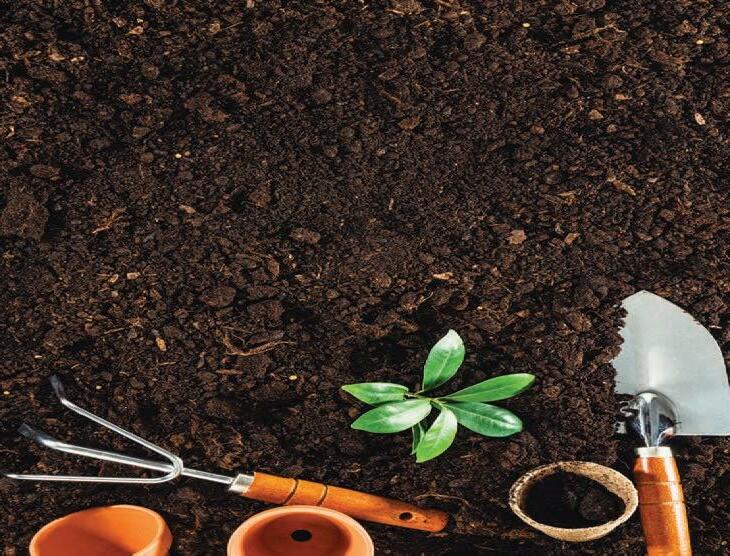

Hannah Wente grew up as a 4-H kid on the shores of Lake Michigan. She is a freelance writer and graphic designer based in Madison. In her previous role as communications director for REAP Food Group, she helped launch the new statewide Farm Fresh Atlas project and supported farm-to-school and farm-to-business efforts. When she’s not gardening, cooking or baking, you can find her playing ultimate frisbee or paddling the nearest lake.

Here at Edible, we work on each season’s issue many months in advance. So as I write this, it is still very much winter and there’s almost a foot of snow on the ground. In fact, I just went snowshoeing on a frozen Lake Monona yesterday. It’s easy to forget about the huge body of water that lies underneath that vast expanse of snow.
Winter, of course, is the season of dormancy. Compared to the lushness of summer, things can look not just dormant, but dead.
But there’s so much more going on than meets the eye—processes of renewal and transformation flying just below the radar of our five senses.
So maybe that’s why when they reveal themselves to us, these mundane events can feel like micro-miracles. A newly germinated seed, biding its time in dirt and darkness, finally emerges from the soil waving a little green flag, as if to say, “yes, hello, I’m alive!” (p. 19) Kefir grains rearrange the constellation of milk microbiota to create something new that tastes tangy, lasts longer and digests easier. (p. 14) As a batch of kombucha brews, the SCOBY expands to the edges of its container and teems with life, bringing a burst of bright flavor and goodness for the gut along with it. (p. 12) This sense of awakening is what spring is all about, and you’ll find plenty of it throughout these pages.
As the weather warms up and the earth begins to come alive, natural areas offer wild foods for those curious enough to find them. (p.32) As the shy spring sun rises higher in the sky, so do our hopes for our gardens, personal and communal, (p. 9) We’re also finding flickers of hope in our region’s restaurant scene. In this issue we cover four courageous chef-entrepreneurs as they shift directions to feed our community and find a way to thrive in spite of the pandemic. (p. 39)
And if, somehow, all of that is not enough to get you excited for spring, take a look at our brunchthemed Cook at Home recipe column to whet your appetite. (p. 27) Herby French toast, shaved asparagus frittata and goat cheese biscuits abound. Cheers!
Let’s dig in.
Lauren Langtim, Managing Editor
P.S. As always, we welcome your thoughts and feedback. Drop us a line at hello@ediblemadison.com.















We can’t wait to get out and (safely) explore farmers markets again this spring! Mark your calendars for market day trips and neighborhood adventures, check out our resource guide for market start dates and more spots to explore along the way. Visit ediblemadison.com/local-guide.
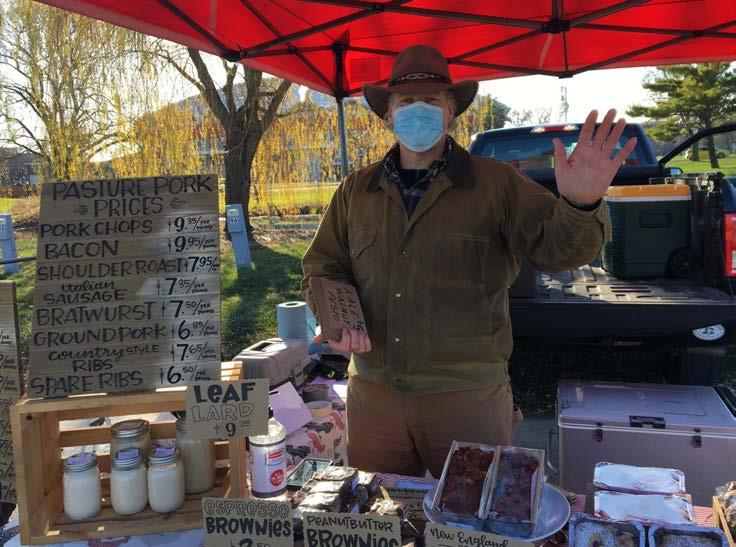
Wisconsin State Natural Areas Program provides guidance on where to explore and what can be harvested without a permit from State Natural areas. Learn more: dnr.wi.gov/topic/lands/naturalareas.
Learn all about mushroom identification with virtual lectures presented all spring by the experts of the Wisconsin Mycological Society. wisconsinmycologicalsociety.org


What started as a commitment to create connection between the renowned Milwaukee urban farm Alice’s Garden and the rich art and agricultural work of the Wormfarm Institute in Reedsburg continues to grow. This network of cultural and agricultural producers are activating projects and events across Wisconsin’s rural-urban continuum.
Learn more and get involved! ruralurbanflow.org wormfarminstitute.org alicesgardenmke.com
Courtesy of Alice’s Garden Courtesy of Dane County Farmers MarketNew to growing your own or need fresh ideas to shake up your garden routine and get more out of your beds?

Megan Cain is a wealth of local knowledge, and her website, social media and emails will help you get the most out of your garden patch this year!
creativevegetablegardener.com
The Garden Network is ready to help you find your garden home. Explore community gardens in your area and get your hands into the soil. danegardens.net
Chef Lauren Montelbano, a leader in the plant-based food scene, published her first cookbook this year! Grounded: Conscious Plant-based Cuisine is available at local shops and online. Get ready to explore your kitchen in a new way and cook with Lauren through the seasons. thevibrantveg.com

Welcome spring with warm, brothy soups, protein- and fiber-packed bowls, and foods that align with the season. We crave brothy soups all year long, but especially in the spring! Our favorite bowl is pho (pronounced “fuh”) from Saigon Noodles. They serve up their traditional Vietnamese noodle soup with crunchy sprouts, fresh herbs, lime, and your choice of protein.
saigonnoodles.co
Chef James Blo odshaw cooks up plant-based versions of everyday favorites at Just Veggiez. Check out his weekly menu, and order now to make your spring season a little easier. justveggiez.com @justveggiez
Kosa Kitchen prepares authentic Indian recipes, handed down over generations, combined with Ayurvedic principles for healing meals that nourish the mind, body, and spirit. Don’t miss out on their seasonally aligned offerings. kosaspa.com/offerings/kosakitchen
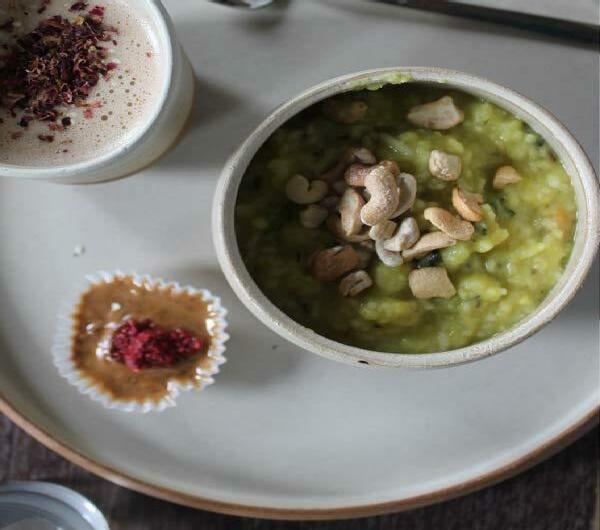




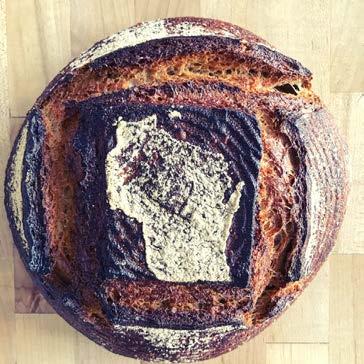





There’s a lot to look forward to at Olbrich Botanical Gardens this year. Here are a few neat garden projects to keep an eye out for as the weather warms up...
Indigenous Garden Project: Olbrich will grow a kitchen garden full of traditional Indigenous foods such as Lakota winter squash, Cherokee Trail of Tears pole beans, Potowatomi lima beans, Hopi red dye amaranth and much more. The garden will feature a natural arbor-supported tunnel made of sunflowers, beans, and corn.
Native Plants: The Herb Garden courtyard will include a cheery ornamental planting emphasizing plants native to North American plains and prairies, which are drought tolerant and good for pollinators.
Plant it on the Patio: Love to garden but don’t have a ton of space? Glean some inspiration from this collection of fruits and veggies well-suited to container growing. All produce generated at Olbrich Botanical Gardens is donated to the Fritz Food Pantry at the Goodman Center.
TradeRoots Afrodiasporic Gardens grows culturally important crops and varieties from the African Diaspora in gardens around Madison. The project, a collaboration between TradeRoots Culinary Collective and UW-Madison launched in 2020, seeks to grow awareness of the rich and storied agricultural heritage of Black farmers and increase community access to these foods. Ecologically diverse plantings feature heritage varieties of okra, sorghum, callaloo, celosia, melon, sweet potato, eggplant, sesame, peppers, and pigeon peas.
Due to the COVID pandemic, public pop-up dinners and other events weren’t possible in 2020, but produce was shared with community members through a partnership with Badger Rock Neighborhood Center. Moving forward, the gardens at Eagle Heights, West Madison Agricultural Research Station, and Troy Farm will support connections between people and the land by providing space for pandemic-safe events that highlight versatile farming methods and culinary traditions surrounding crops of Black cultural significance.
During the growing season, community workshops will provide tips on gardening, seed saving, and ways to preserve the harvest through canning, drying, pickling, and fermenting, while outdoor meals will showcase the seasonality and stories behind the harvest.


10 • SPRING 2021 Switzerland. Naturally.
Elevate your next wine pairing with LE GRUYÈRE® AOP , made for over 900 years from the purest cow’s milk in the Swiss Alps. Gruyère AOP’s nutty complexity sings with Chardonnay, boosts a Beaujolais, and perfects a Pinot Noir. For more information and some great recipes and pairing ideas, visit us at gruyere.com. Cheeses from Switzerland. www.cheesesfromswitzerland.com


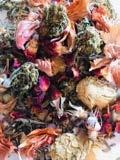

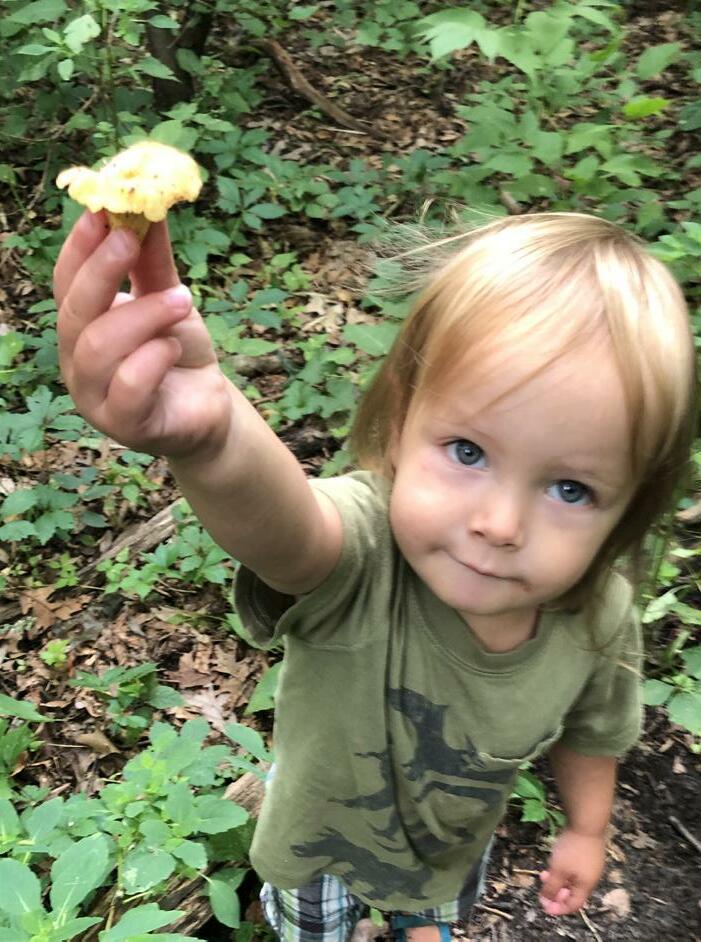


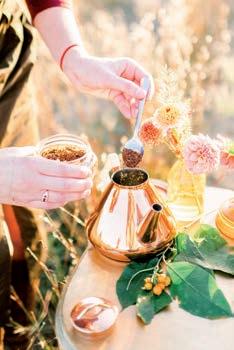


Blue

There’s never been a better time to give kombucha a try, with three commercial kombucha operations in Dane County plus The Kombucha Shop that sells DIY supplies.
launched in
2008 by friends Alla Tsypin and Vanessa Tortolano to provide live culture beverages to the community, was among the first commercial craft kombucha operations in the world. “We’re passionate about what we do. We brew kombucha with traditional methods, innovating with flavors that are complex yet inviting,” says Tsypin, who remains at the center of the operation. Their kombucha tends to be off-dry with a gentle cider-like acidity and an endlessly complex blend of tea, botanicals and fermentation character. When sipping their Traditional Oolong, one finds notes of peach candy, cantaloupe, navel orange and strawberry, all from the intersection of the black tea and live cultures. They are complex enough to contemplate like a barley wine, cognac, or Bordeaux, yet they are easy to sip anytime. Expect medium low carbonation, an off-dry finish and bright yet complex flavors from NessAlla. NessAlla is certified organic and available in glass bottles, growlers, and kegs.
launched circa 2017 on the menu at Forage Kitchen, that then took off on its own trajectory, highlights the Rishi tea blend of each flavor in a bubbly format. “We are a local company with Madison roots, trying to create a nice, fun beverage to make kombucha more accessible for people,” according to cofounder Henry Aschauer. Their Raspberry Kombucha is clearly raspberry throughout, even boasting a lovely blush hue, with added complexity of dried apricot and vanilla notes coming from hibiscus included in the tea blend. Expect a beverage as carbonated, dry and refreshing as your favorite sparkling water, but with flavor from real produce and botanicals; available in cans.
, launched in 2017 by Lacy Rude as a tribute to her father who taught her to make kombucha in the mid-90s, and a showcase for local botanicals and produce, operates on a small scale out of the Northside FEED Kitchen. Her kombucha pushes fresh fruit and herbs to the foreground, all sourced from local farms like Future Fruit Farm in Ridgeway or Rude’s own garden. The Ginger Pear bursts with herbal pear skin notes and creamy baked pear richness with obvious warmth from the ginger, plus low green tea, a balanced touch of lactic and acetic acid before finishing dry. All that, along with the medium, naturally occurring carbonation, and it seems like a champagne bottle of sparkling pear juice if those were actually deli- cious. “It’s a fresh and light kombucha. I’m using locally grown fruits and herbs—every flavor has Wisconsin-grown fruits or herbs,” Rude says. Expect a dry, fruit-forward sparkling beverage with a gentle tea and acid note; crisp and easy like lemonade. Rude Brew is available in glass bottles, growlers, and kegs.

Kombucha is a fermented beverage based on four simple ingredients: water, tea, sugar and SCOBY (symbiotic culture of bacteria and yeast).
SCOBY





sugar water
tea
kombucha
The tea serves as both a flavoring agent and a nutrient source for the SCOBY during fermentation as it metabolizes the majority of the sugars.
The general result is a mostly dry, tea-flavored beverage with a bit of acidity and carbonation. The opportunities within this basic formula are as great as the range of beer or wine styles, as the Madison-area producers clearly demonstrate.
“Only 4% of the population has tried kombucha,” according to Alla Tsypin of NessAlla Kombucha, so odds are not great that you have had it yet. But with the ready supply and the flavor range among local kombucha, there is likely one to thrill your palette.
One of the common features of kombucha is a noticeable acidity or sourness. It can range from barely noticeable to obviously tart. The acid from kombuchas provides a refreshing cut to fatty or sweet foods and compliment salty foods. Whether you choose to pair your kombucha with food or drink it all on its own, the resounding message from all three producers is: Give it a try! There’s a local kombucha out there for you.
There are many different types of cultured dairy products originating from just about every part of the world. Fermentation was used for centuries in traditional diets to preserve milk prior to the existence of refrigeration, but it also added beneficial bacteria and yeasts that improved milk’s digestibility and nutrient content, and promoted health. Kefir, originally hailing from Eastern Europe, is a cultured dairy product similar to yogurt, with a notably tangy flavor. While tart and creamy like yogurt, kefir has a thinner consistency, which lends well to smoothies and sauces.
of course), which hold the cultures together. While you cannot start kefir SCOBYs at home from a pre-made batch of kefir, you can buy them from online sources like Cultures for Health or Kombucha Kamp. Alternately, you may find a friend or neighbor already making their own kefir to give you some grains, as they do grow and multiply over time as you produce more batches of homemade kefir.
Kefir also differs from yogurt in the way it is produced. It is fermented using different microbial organisms, or cultures. Most yogurt cultures are thermophilic, meaning they must be incubated in a warm environment for proper fermentation. Kefir’s cultures, by contrast, are mesophilic and can ferment at room temperature with no need for incubation or special equipment.
Most yogurts are fermented with a starter culture of previously-made yogurt, similar to how sourdough bread is made. Kefir, on the other hand, cannot be made in this way. Instead, you must begin with a specific kefir starter culture, also known as kefir grains. These are actually not grains at all but are named this because of their appearance. The kefir starter is actually a SCOBY (an acronym for symbiotic colony of bacteria and yeast) culture, akin to the starter used for making kombucha. While a kombucha SCOBY is a layered and disc-shaped, kefir grains come in a group of smaller, cauliflower-like pieces. Maybe it’s my Wisconsin showing, but I think they look like large curd cottage cheese, both in texture and opacity. The clumped structure and gelatin-like texture of these “grains” come from various polysaccharides emitted by microbes, such as kefirin (named for kefir,
Nutritionally speaking, kefir is a fantastic food to include in your diet. Like other milk products, kefir is a great source of nutrients, including calcium, phosphorus, magnesium, B vitamins, trace minerals and fat-soluble vitamins. As a fermented food, it is rich in beneficial bacteria and yeasts, which have been shown to promote digestion, immune function, and more. The microbes in kefir reduce the lactose content of the milk as it ferments, making it more digestible for some who are sensitive to the lactose in dairy. If you are sensitive to cow’s milk, you could try kefir made from goat or sheep milk instead to see if it is better tolerated.
I typically use kefir like I would yogurt, often eating it plain, but I also serve it with a handful of homemade granola, a drizzle of raw honey or some fresh fruit. I also put my kefir in creamy salad dressings, marinades, smoothies, quick breads, oatmeal, and any sauce in which I might normally use cream or yogurt, such as tzatziki. You can even make your kefir with heavy cream instead of milk, creating a perfect crème fraîche substitute. I am sure you will find your favorite way to use your homemade kefir after you have made a batch or two as well. If you are new to fermentation, beginning your journey with milk kefir is a great place to start. In just 5 minutes of prep time, you are on your way to healthy, delicious milk kefir.
Photo by Sunny Frantz / Props provided by Century HouseAs a fermented food, it is rich in beneficial bacteria and yeasts, which have been shown to promote digestion, immune function, and more. The microbes in kefir reduce the lactose content of the milk as it ferments, making it more digestible for some who are sensitive to the lactose in dairy.

Yield: 1 quart Prep time: 5 minutes
Fermentation time: 1 to 3 days
1 quart whole milk (can be raw or pasteurized, or substitute heavy cream)
2 tablespoons fresh, active kefir grains
EQUIPMENT
1 quart-sized glass jar
1 non-reactive jar lid (I use BPA-free plastic lids.) Mesh strainer
1. Pour milk into a glass jar. Add the kefir grains and stir well.
2. Place the lid onto the jar, being sure not to screw on too tightly, letting out any gas produced during fermentation.
3. Ferment the kefir at room temperature on the counter top for 1-3 days. The kefir is done and ready to use when it has thickened and has a tart, lightly acidic flavor. It may even become a bit effervescent or begin to separate. If your kitchen is warmer than room temperature, this may happen faster, whereas cooler temperatures will cause a slower fermentation process. Check it regularly as it sits, as fermentation times will vary.
4. Once fermented, pour the kefir through a mesh strainer into a clean glass jar to collect the grains and kefir separately. Transfer the prepared kefir to the fridge for storage, where it will keep for several weeks.
5. The kefir grains can now go right into another jar of milk to start your next batch of kefir, or the grains can be stored in the fridge until you are ready to make another batch. Simply put them in a small jar with just enough milk to cover the grains. Stored this way, your starter culture can remain dormant and healthy for a few weeks until used again.


Add-ins like cinnamon, vanilla, honey or berries can be used to spice up single-fermented kefir just before serving.
Similar to the kombucha-making process, you can put your kefir through a second round of fermentation, which adds more effervescence and tang. In the second fermentation, you can add fruit or other flavors to the vessel to make it all your own. This extra step is not necessary, but some people enjoy it for the different flavors it provides.
To do a second fermentation, put the strained kefir into an airtight vessel, such as a flip-top bottle used in beer brewing or simply use a glass canning jar. You can leave this plain or add fruits or flavorings as desired. Let sit at room temperature for 1-2 more days until effervescent. Be careful when opening in case of overflow due to contents being under pressure. Once fermented a second time, store in the fridge for up to several weeks.
Your kefir may begin to separate, forming a layer of thin liquid (whey) on top, which is totally fine—this is simply a sign the kefir is wellfermented and does not necessarily indicate spoilage. If separation occurs, simply shake or stir to combine and you are good to go. Mold or unpleasant “off” odors, however, are signs of unwanted microbial growth. If these signs show up, strain and toss the kefir, then rinse the grains and start a new batch with fresh milk.
Your kefir grains will grow and multiply as you prepare more batches of kefir; you only need 2 tablespoons of starter to make a 1-quart batch, so any extras can be used to make multiple or larger batches of kefir, can be stored in the fridge, or can be shared with a neighbor ready to ferment!
learn more at ediblemadison.com/
Serves : 2-4
Prep time: 5 minutes;
INGREDIENTS
2 cups plain, whole milk kefir
2 tablespoons raw honey
2 teaspoons ground turmeric
½ teaspoon ground cinnamon ¼ teaspoon ground cardamom
¼ teaspoon ground ginger (or sub 1 tablespoon chopped, fresh ginger)
Optional: 1 cup frozen, diced mango or banana
DIRECTIONS
Mix all ingredients in a blender and blend until smooth and all ingredients are well incorporated.
Divide among glasses and serve, or refrigerate and enjoy later.
Turmeric gives golden milk its signature yellow color and adds antioxidant compounds. Turmeric, along with ginger, are known for their anti-inflammatory properties. Turmeric’s medicinal compounds are not well-absorbed from food unless combined with black pepper or fat. In this recipe, the whole milk kefir lends the healthy fat to help improve turmeric’s absorption. Feel free to add a sprinkle of black pepper to yours for an extra kick!
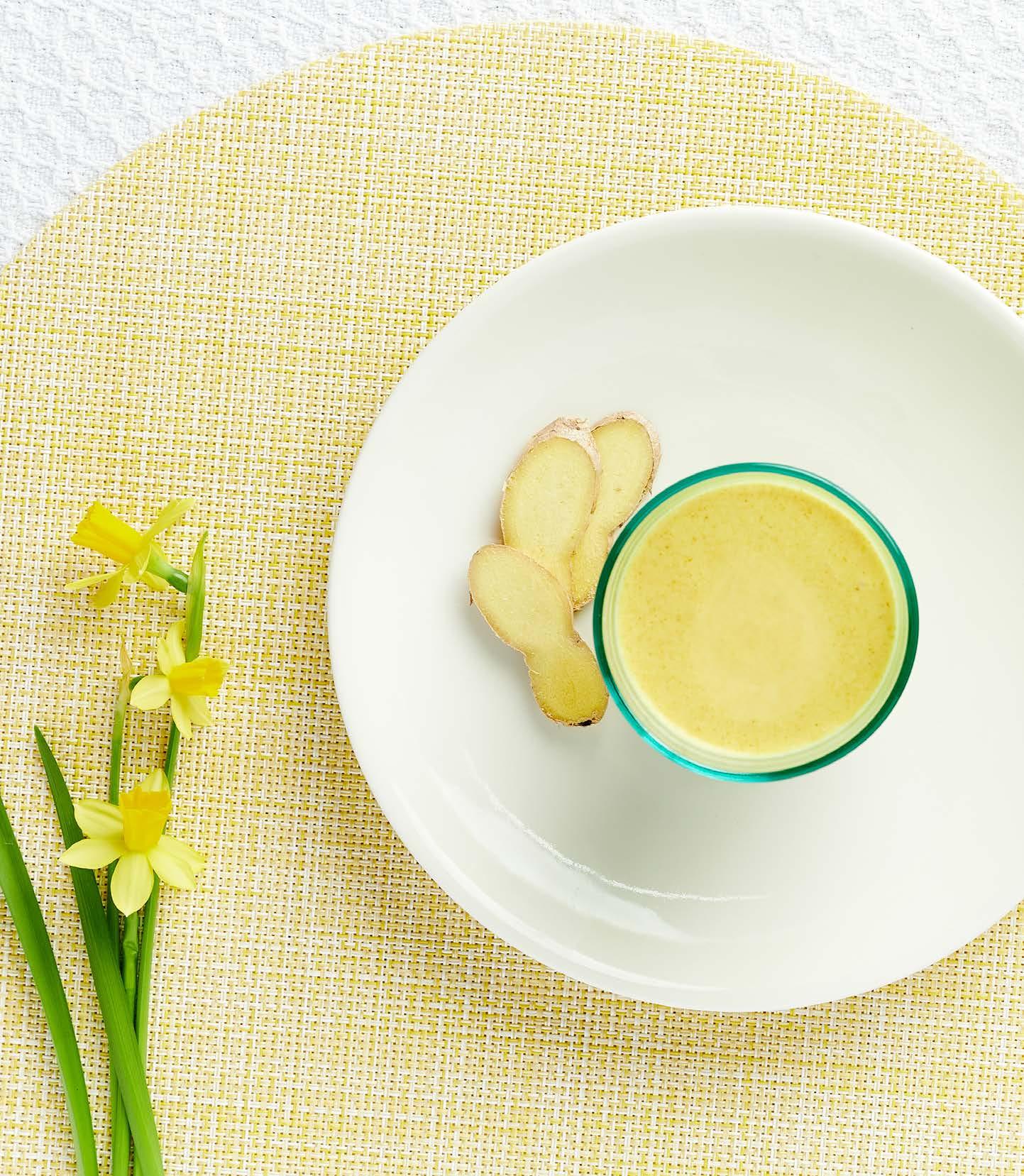
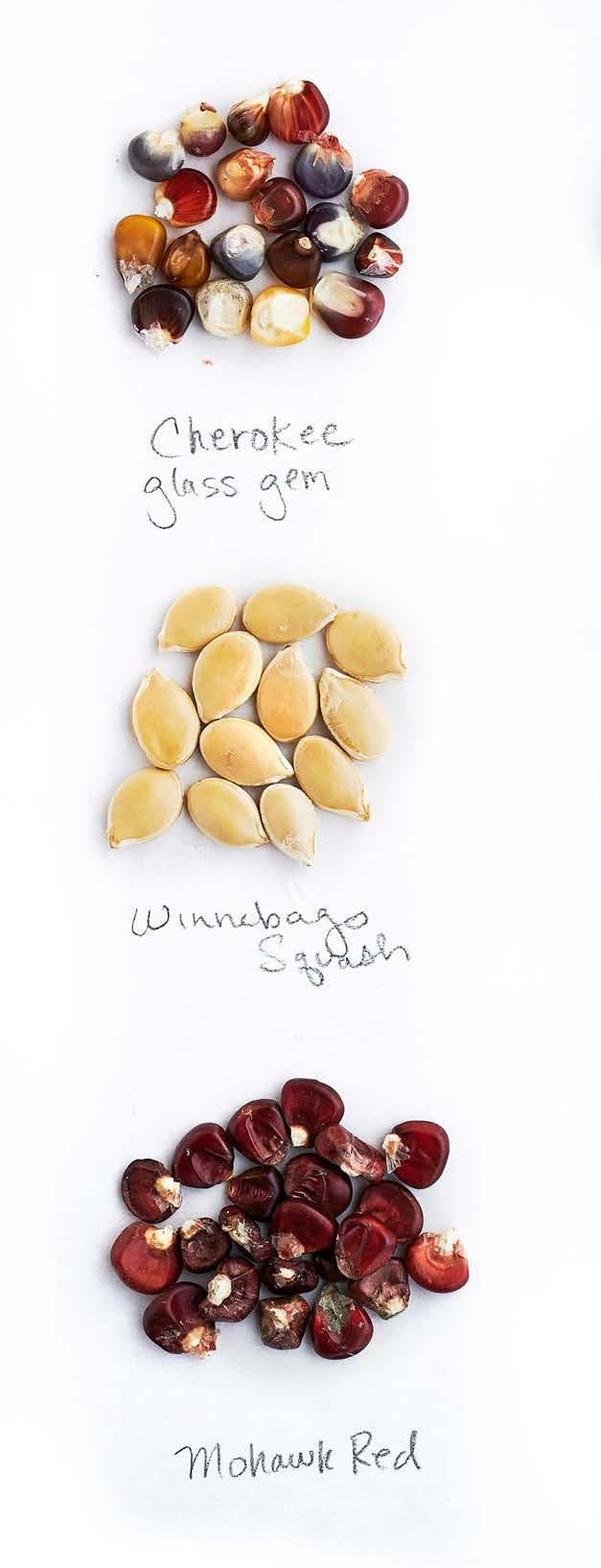

To begin to appreciate the power of seeds, we must first understand the role in which industrial agriculture works to control them. Despite the energy and infrastructure behind patenting, modifying, and owning seeds, there is a growing movement of intergenerational Indigenous seed keepers, farmers, and chefs working to regenerate the seed security that was uprooted by the commoditization of the agricultural landscape. “I wish that people would just pay more attention to their food systems and what happens with genetically modifying what you eat,” says Elena Terry, of the Ho-Chunk Nation. “Unfortunately, you get into this political, economic conversation about the fact that people are starving, so if they have to purchase this very cheap, highly processed food, that’s what it has to be. But how can we change that?” Elena is the founder and executive chef of Wild Bearies, an educational non-profit based in Wisconsin Dells, that connects Indigenous communities through a mentorship program and seed-to-table culinary events. She has emerged as a leader in Native food reinvigoration through her work as a chef, seed keeper, and community organizer. She has had an impact not only on the regional level but is also an integral part of the larger Indigenous seed movement.
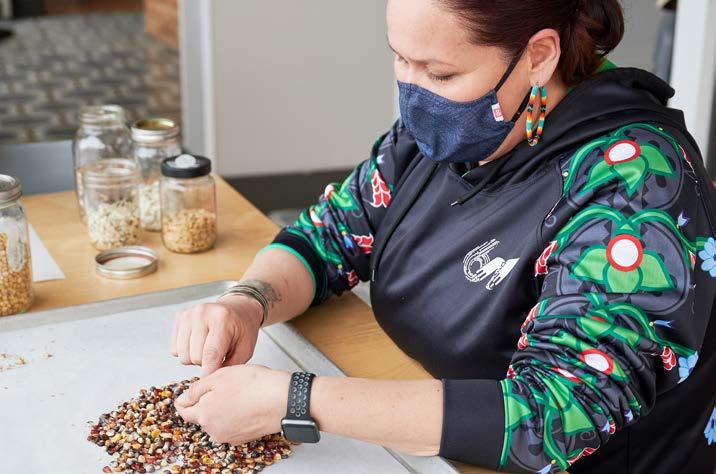
Elena’s journey through her Indigenous food heritage began with her passion for cooking and sharing her unique approach to traditional Ho-Chunk foods with her community. By following her deep interest in connecting with food at the source, Elena has become a respected pit master, butcher, forager, and keeper of seeds. Prior to establishing Wild Bearies in 2018, Elena had been a tribal legislator for the Ho-Chunk Nation. After realizing that she would be a more effective leader working directly with food and sharing her ancestral traditions through her cooking, she decided to make the leap into centering her life around food. “I have always cooked for ceremonies, and I feel connected to our spirituality through our food. I was part of the Great Lakes Intertribal Food Summit and through that became a part of the Native American Food Sovereignty Alliances pilot mentorship program. During those experiences, Wild Bearies kind of manifested itself and I’ve just been along for the ride.”
Native communities’ work to reclaim their traditional food systems has been built on a collective effort that is coordinated among a network of inter-tribal leaders who work together to rematriate seeds to their origins. Elena explains, “I don’t like to think that people are the ones who do it. I really feel that the seeds are the ones that dictate when it’s time to go home and that people are the vessels that bring them there. Those seeds going back to where they came from is the rematriation. Some of those seeds have been sheltered or kept in a safe place because it wasn’t safe for them to be where they were originally meant to be, so they were protected. The mothers are going home to care for us.”
In Elena’s work within the Indigenous network of seed keepers, Jessika Greendeer, her grandmother through the Ho-Chunk kinship system, has had an incredible impact both as a collaborator and mentor. Jessika is the Vice President and a founding board director of Wild Bearies as well as the Seed Keeper and Farm Manager at Dream of Wild Health, a non-profit farm organization that serves the Twin Cities Indigenous community through a CSA program, farmers market and Indigenous seed collection. Following military service, Jessika completed the Veteran-to-Farmer program at the Rodale Institute in Pennsylvania. Jessika has brought her experience and wisdom of Indigenous growing practices full circle from her work in the garden as a child, to her time at Rodale Institute, and now as a leader in her farming community. “The more I look at Indigenous farming, the more I realize that we were the original regenerative farmers. Regenerative practices are just the methods of farming that we use. It’s not extractive to the Earth. It’s about forming a relationship with the Earth and by doing that you take better care of her.”

We all knew it was about taking care of one another, but also sharing our abundance with each other.
The solution to our food issues is about trying to get back into that mindset.Jessika visiting UW West Madison Farm ^ Paint it like a Horse beans almost ready for harvest > Photos by Jesse Perkins
After meeting at a Ho-Chunk food-tasting competition, Jessika and Elena began supporting one another through seed saving and food sourcing. Jessika remembers how Elena and her daughter, Zoe, helped her plant a quarter acre of corn, squash and sunflowers. “Seed work is slow work. As much as you want to be able to grow acres and acres of something, when you start off with a handful of seeds, that takes a long time to get it to that population size. While I was working for the tribe, I had put a call out for anybody who could help me do this hand seeding. The only person who kept showing up was Elena and she would bring Zoe along. Zoe already had caught the seed bug, whether she knew it or not.”
The choice of Zoe to continue in the culinary and seed keeping tradition of her mother and her kindred grandmother illustrates the power of generational knowledge. “I’ve worked in the kitchen with my mom for over five years, but this summer I had the opportunity to go and work with Jessika at Dream of Wild Health. It was eye- opening to be able to work with the ingredients and know where they come from and how they are grown. To see what it takes to grow seeds and care for them, to be part of feeding people has been beautiful. I’ve worked in the whole spectrum of seed production now and being able to study with some of the most knowledgeable people is very meaningful to me.” Jessika explains the Indigenous approach to keeping and multiplying seeds, “with all of our seeds we consider them members of the extended family because seeds are living beings and so it’s not something that you can just sell. Like we can’t sell human beings. As Native people we look at the perspective of The Seven Generations. It’s not only looking for what’s going to happen today or even a year from now but thinking seven generations from now. Everything that we do today is going to ripple into our future generations or the generations who have yet to come to Earth. Like seed keepers have thought of us long before we ever came here. And that’s not just for Indigenous people, but it’s all around the world.”
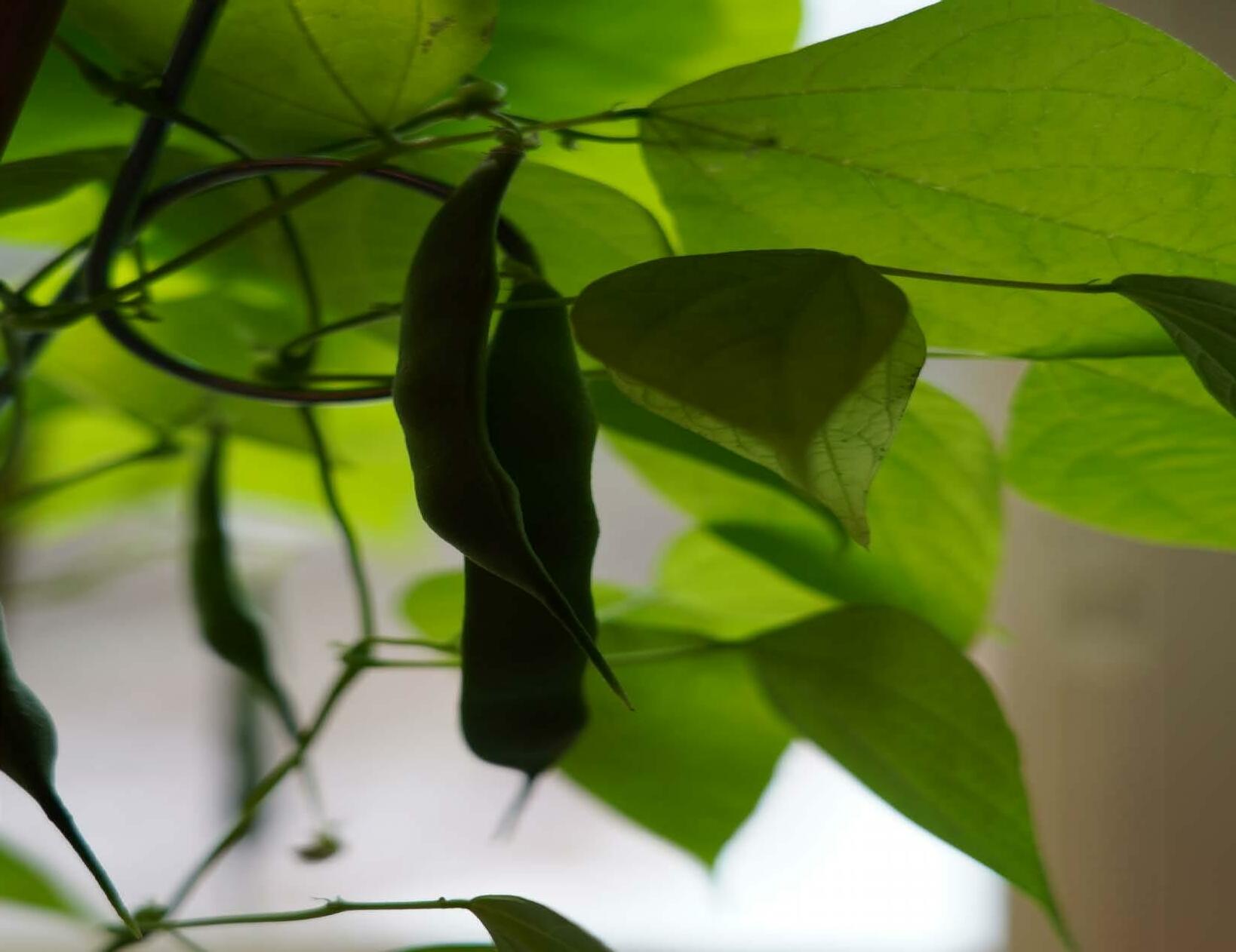
Everything that we do today is going to ripple into our future generations or the generations who have yet to come to Earth.
This past summer Elena traveled to the Pacific Northwest on Indigenous trade routes visiting farmers, traditional food knowledge keepers and seed savers along the way. The wildfires and hailstorms that devastated much of the West also had an impact on the seeds that were to be harvested this year. In the cycles of seed production, some seed must be planted while some seed must be saved. When conditions like natural disaster, disease or pests wipe out a crop, Indigenous seed keepers support one another by trading, sharing, and storing seed in various locations. Elena talks about how the Native seeds that were stolen from Indigenous communities are kept safe through a group of trusted seed keepers, “We can share some of the seed but some of it has to be protected. And those conversations need to happen. Because once we start talking about intellectual property it really is a matter of making sure that those seed lines are kept safe from ill intentions.”
Indigenous trade routes weren’t historically limited to North America. Elena and Jessika both feel connected and inspired by the Indigenous foodways not only of the upper Midwest but also the entire Western Hemisphere. Jessika points out that trade and knowledge sharing spanned from South America all the way into Canada, “A lot of what Elena did this past summer was ultimately based on our Indigenous food trade routes, pre-European contact or even post-contact. During an archaeological dig down in South America there was evidence of wild rice. Even as far as Canada, at another archaeological dig, there was evidence of cocoa in a pot. These dig sites were from thousands of years ago. At one time all Indigenous people across the Americas had traded not only food, but different goods and items with one another even though we spoke different languages. We all knew it was about taking care of one another, but also sharing our abundance with each other. The solution to our food issues is about trying to get back into that mindset.”
 < Zoe removing Winnebago Squash seeds to save.
Photo by Jesse Perkins
< Zoe removing Winnebago Squash seeds to save.
Photo by Jesse Perkins
For Elena, keeping alive ancient traditions through sharing knowledge within her community is at the core of her work as a mentor, chef and mother. In an excerpt from an essay written for an anthology to be published for the Inter-Tribal Ag Council, Elena beautifully shares the depth of importance in her work:
Our grandmothers, the matriarchal knowledge keepers, knew the importance of continuing these teachings. The way that they shared the knowledge with us was by implanting it in our sensical memories. The way the fire crackled, or the corn felt, or the way the forest smells...all these feelings embed in the activities that went along with them. All harmoniously intertwined by the calm sound of my grandmother’s voice. These were the seeds of strength, resilience, compassion, kindness, and endurance that were planted as blood memories. Those memories will continue deep within our DNA, as a gift from our grandmothers. In continuity, we will share these stories, knowledge, and good intentions with our grandchildren.
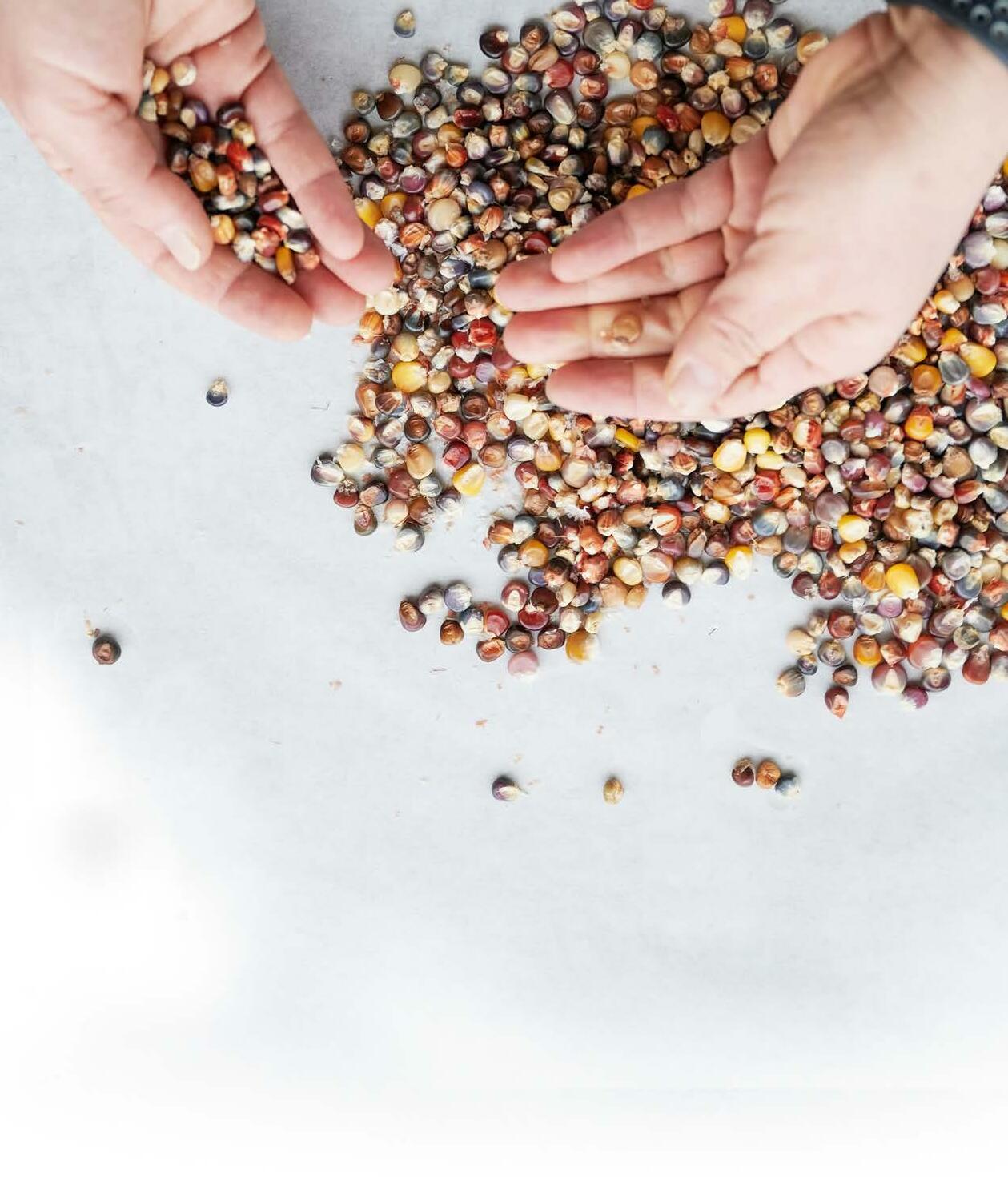
We are our grandmother’s prayers.Photo by Sunny Frantz
Serves 4
Prep time: 30 min
Cook time: 35 min
INGREDIENTS
1 ¼ cup unbleached flour
¾ cup blue cornmeal
2 tablespoons flaxseed meal or 2 eggs
1 ½ teaspoons baking powder
1 tablespoon sugar
pinch of salt
1 cup plus 1 tablespoon unsweetened almond milk
¼ cup coconut oil or butter
1 ½ teaspoons vanilla
2 tablespoons maple syrup
½ cup cooked and cooled wild rice
1. Sift together the dry Ingredients into a bowl and set aside.
2. Whisk the wet ingredients together in a separate bowl.
3. Make a small well in the center of the dry ingredients and slowly pour in the wet ingredients. Mix together until combined. Do not over mix.
4. After combining the wet and dry ingredients together to get a smooth batter, let the batter rest for 3-5 minutes.
5. Mix in the ½ cup of wild rice.
6. After all of the ingredients have been combined, take spoonfuls of the batter and pour it into a hot waffle iron. Be sure not to overflow the waffle iron.
7. Cook the waffles until a golden brown color is achieved.
8. Top with additional maple syrup and berries. Enjoy!












COOK AT HOME
The flavors of spring can be slow to appear, so—we’re ready to savor every single morsel the moment it comes out of the ground.
Small cafe owner Virginie Ok has been bringing French flavors to Madison since she opened La Kitchenette on Willy Street in late 2016. Her savory French toast celebrates some of the best flavors of early spring. With fresh greens and herbs in the French toast batter and an earthy mushroom sauce covering each slice, you are sure to enjoy this elegant recipe.
Serves 4
Prep time: 30 min
Cook time: 35 min
INGREDIENTS
5 eggs
3/4 cup milk
1 ¼ cup heavy cream, divided ¼ cup spinach
1 scallion, cut into 1-inch segments
½ cup fresh tarragon, plus more for plating
½ cup fresh dill, plus more for plating
1 cup raw hazelnuts
4 pancetta slices
4 tablespoons butter, divided
1 shallot, diced
1 garlic clove, minced
4 cups sliced mushrooms (button, cremini, shiitake)
½ cup dry white wine
1 cup chicken or vegetable stock 1 tablespoon cornstarch
Kosher salt
8 slices bread - preferably day-old brioche sliced 1” thick 2 tablespoons hazelnut oil (or other neutral cooking oil)
3 cups sliced portobello mushrooms

1. Preheat oven to 350 degrees F.
2. In a blender, combine eggs, milk, 1/2 cup heavy cream, spinach, scallion and herbs. Blend until smooth and combined.
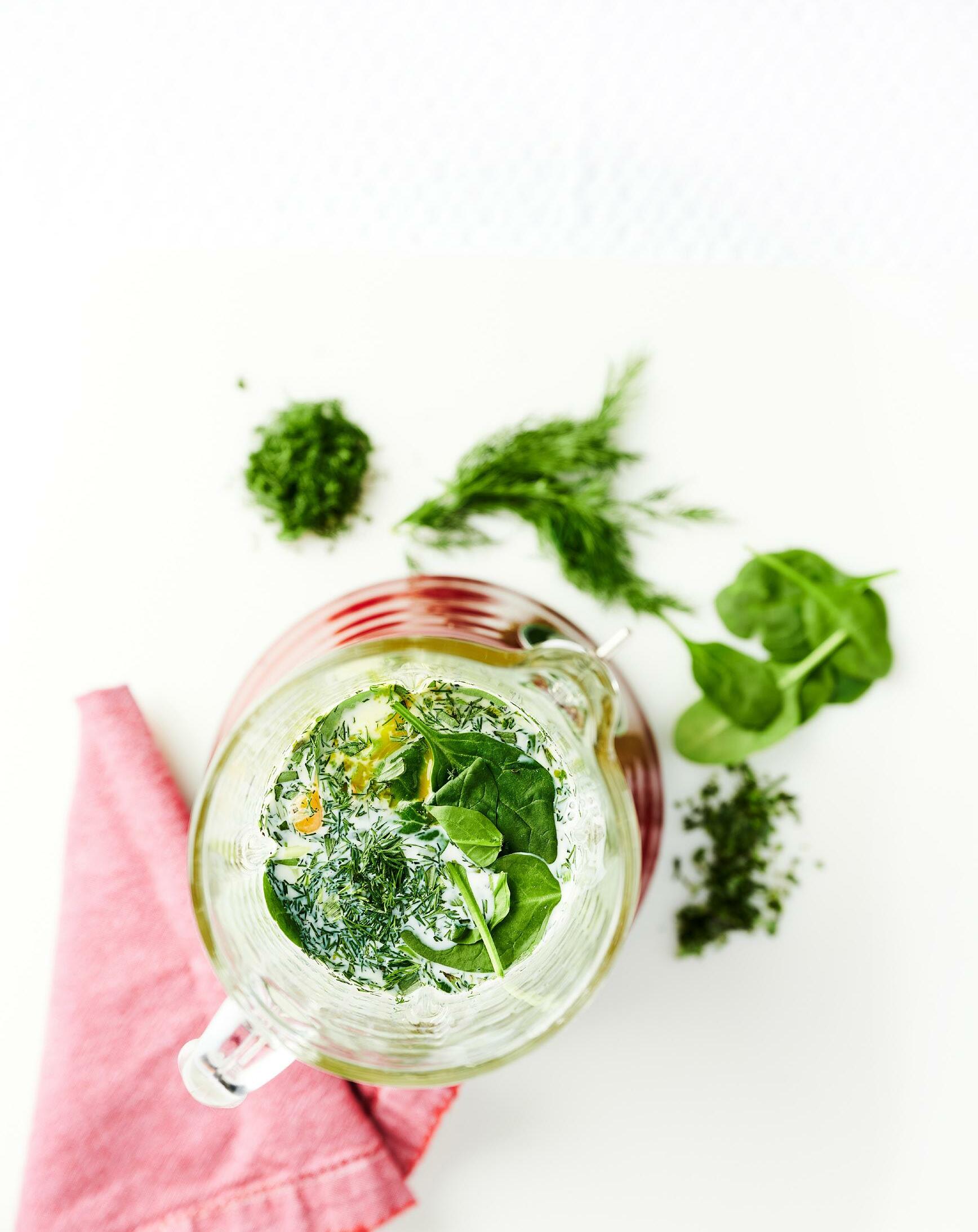
3. Pour the batter into a deep flat bottomed dish. Set aside.
4. Roast hazelnuts in preheated oven for 15 minutes. Let cool then rub a towel around the nuts to remove skins. Place the nuts into a bag on a flat surface, and crush them gently with a rolling pin. Set aside until ready to plate.
5. Increase oven temperature to 450 degrees F. Place pancetta slices on a baking sheet, and bake until crisp, about 10 minutes. Roughly chop and set aside until ready to plate.
6. In a large saucepan, heat hazelnut oil over medium heat. Sear portobello mushrooms until browned around the edges, about 10 minutes. Remove to a plate and set aside until ready to plate. Don’t bother cleaning out the pan.
7. In your large saucepan, melt 2 tablespoons butter over low heat. Add shallots and cook until they turn translucent, about 10 minutes. Add garlic and stir until fragrant, 1 minute more. Add mushrooms and cook until they begin to soften. Pour in wine and stock, and bring to boil. Reduce heat and let simmer until reduced, about 15 minutes.
8. Stir the cornstarch into the remaining 3/4 cup heavy cream, then add to the mushroom sauce and cook until thickened. Add salt to taste.
9. Quickly dip each brioche slice in the batter and transfer to a dry plate.
10. Over medium heat, melt 1 tablespoon butter on a nonstick pan or griddle and fry brioche slices on both sides until golden brown, about 2 minutes per side. Add remaining 1 tablespoon butter when pan gets dry, if needed.
11. To serve, place one slice brioche on a plate, pour the sauce over, place another slice on top, and add more sauce. Top with the seared mushrooms, pancetta chips, crushed hazelnuts and any remaining fresh herbs.
Fresh herbs, asparagus stalks, hoop house greens, and foraged mushrooms bring so much flavor to these early spring days. Pair these recipes with some hash browns using the last of the storage roots and you’re officially ready for warmer weather.
Ashley and Karissa met as bakers at Beans n Cream Bake-house in Sun Prairie, connecting over traditional baking and unique flavor combinations. It was this passion that led them to start up Blue Violet Jams and Jellies, creating small batch spreads with a botanical twist. They created

Serves 4
Prep time: 20 min
Cook time: 25 min
INGREDIENTS
2 cups all-purpose flour
4 teaspoons baking powder
2 tablespoons sugar
3/4 teaspoons salt
1/2 teaspoons pepper
3 tablespoons cold butter
¼ cup fresh thyme
Zest of 1 lemon
8 ounces goat cheese
1 ¼ cup heavy cream, divided
INGREDIENTS
1 cup water
1 cup lemon juice
1 cup fresh mint
.8 ounces fruit pectin
1 ¼ cup sugar
1 tablespoon honey
1. Combine water, lemon juice and mint in a medium saucepan. Bring to a boil over high heat. Remove from heat and cover with lid for 10 minutes to steep mint.
2. Strain mint out of liquid and add liquid back to the pan. Stir in pectin and bring to a roiling boil over medium high heat. Stir in sugar and honey, and boil for 1 minute more. Remove from heat.
3. Serve over warm biscuits. Refrigerate remaining jelly.
this tangy biscuit filled with goat cheese, fresh herbs and butter (this is a good time for European-style butter as it yields a flakier biscuit) as the perfect vehicle to carry their jam. Serve them on their own or pair them with a quick jelly of honey, mint and lemon.

1. Preheat oven to 400 degrees F.
2. Combine all dry ingredients in a large bowl. Cube butter and cut into dry mix by hand.
3. Mix in herbs and zest.
4. Add goat cheese and all but 1 tablespoon heavy cream.
5. Very gently knead dough with your hands into a ball. Turn out onto a lightly floured surface and pat to 1-inch thick. Fold in half, pat out to 1 inch. Rotate, fold in half, and pat out to 1 inch.
6. Use a floured 2-inch biscuit cutter to cut out biscuits. Brush with reserved tablespoon of cream.
7. Bake until golden brown, 18 to 20 minutes. Serve warm with jelly.
Ready for those first few asparagus spears of spring? Yeah, me too. This quick spring frittata combines tender shaved asparagus with bacon, Parmesan, and a few fresh herbs for a simple weekday breakfast. The trickiest part is shaving the asparagus. Use your vegetable peeler, hold onto the thick stem of the asparagus and shave the spears until you have nothing left but one tender piece in the center.
Serves 4
Prep time: 20 min Cook time: 20 min
1 bunch asparagus, shaved (about 3 cups)
6 slices bacon
8 eggs
1/4 cup half & half
3/4 teaspoon kosher salt
1/4 teaspoon black pepper
1/4 cup finely chopped fresh herbs (chives, dill or fennel fronds work best)
1/3 cup shredded Parmesan Crème fraîche, optional Fresh greens, optional
Crisp bacon in an oven or skillet. Reserve a tablespoon of the bacon fat to grease the egg pan. Roughly chop bacon and add to a large bowl with shaved asparagus.
1. In medium bowl, combine eggs, half & half salt, and pepper. Whisk until smooth and then add fresh herbs and parmesan.
2. Pour egg mixture over asparagus and bacon. Gently fold mixture together.
3. In a large cast-iron skillet or other ovenproof pan, warm bacon fat over medium low heat.
4. Add egg mixture and cook until edges are set, 5 to 6 minutes.
5. Preheat broiler to high. Cook frittata under broiler until top is golden brown and set, about 2 to3 minutes.
6. Serve warm with dollops of crème fraîche and a side of fresh greens.

More variety lies ahead. Now is the time to clear out the storage cellar and use up those last few lowly turnips and rutabagas. Crispy hash browns provide a perfect pairing to any morning meal.
Serves 4-6
Prep time: 15 min Cook time: 15 min
1 small rutabaga, peeled
1 medium purple top turnip, peeled
2 eggs
1 teaspoon kosher salt
1/2 teaspoon onion powder
1/4 teaspoon freshly ground black pepper
3 to 4 tablespoons bacon fat (or coconut oil)
Shredded cheese, optional Ketchup or hot sauce, optional
1. Shred rutabaga and turnip using a food processor or cheese grater. You want about 3 cups of shredded roots. For extra-crispy hash browns, wrap the shredded roots in a clean dish towel and squeeze out as much liquid as possible.
2. Whisk eggs, salt, onion, and pepper in a large bowl. Add shredded vegetables and stir with a spatula until well-coated in egg mixture.
3. In a large, heavy skillet, heat 2 tablespoons bacon fat (or coconut oil) over medium heat. Once sizzling, add four heaps of shredded vegetables (about half of the total mixture). Cook, undisturbed over medium heat until browned and crisp, about 3 to 4 minutes. Flip and cook until the other side is well browned, 3 to 4 minutes more. Repeat with second half of the mixture, adding more bacon fat or oil if needed.
4. Serve warm with shredded cheese, ketchup and/or hot sauce.
Recipe by Lauren Rudersdorf of Raleigh’s Hillside Farm and The Leek & The Carrot

Stelton Aztec flatware set, Hasami porcelain plates in beige, Iittala Kartio tumbler in water green, and Chilewich bamboo placemats in yellow, provided by The Century House in Madison.
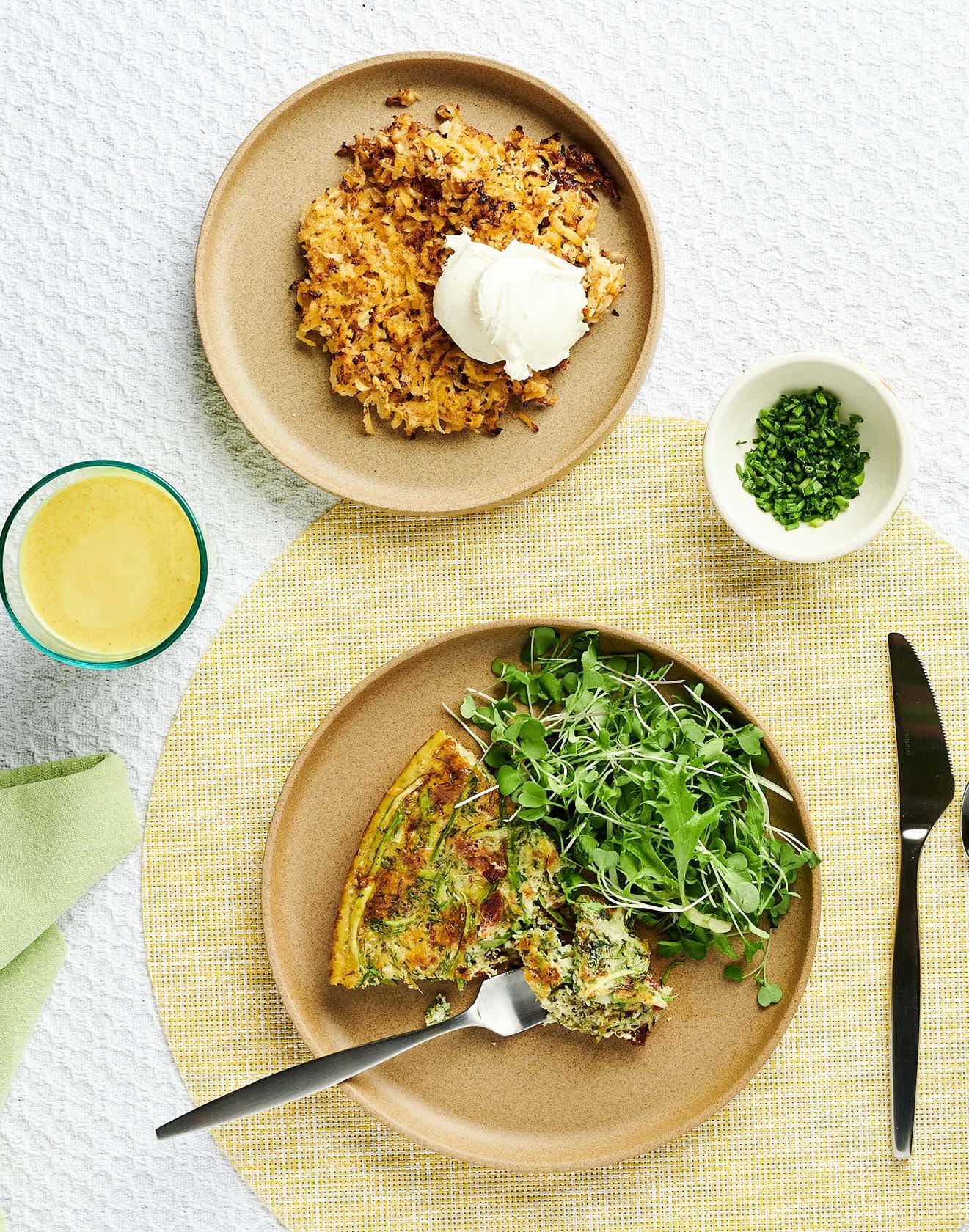
 BY HANNAH WENTE
BY HANNAH WENTE
Andy Gricevich stands before us in the gravel parking lot at Lake Farm County Park in Madison. He’s like a field trip leader—backpack-clad, asking what we know about foraging already, and what we want to learn and find on this trip. He leads foraging tours through his business What Got Gathered.
Andy is no stranger to plants. He worked for Harmony Valley for four years and the Willy Street Co-op’s produce department for eight. Despite the Co-op having “the best produce department I have ever seen,” he argues that foraged foods taste even better. “We’ve bred the wildness out of most of our plants,” he says, “They’ve been coddled. Even in organic farming, some plants have lost their evolved competitive resistance—compounds in the plant that provide flavor and nutrition. Wild plants are more complex, richer and more dynamic. They don’t measure up by comparison.”
^An early spring foraging trip, means fiddle head pizza for dinner.
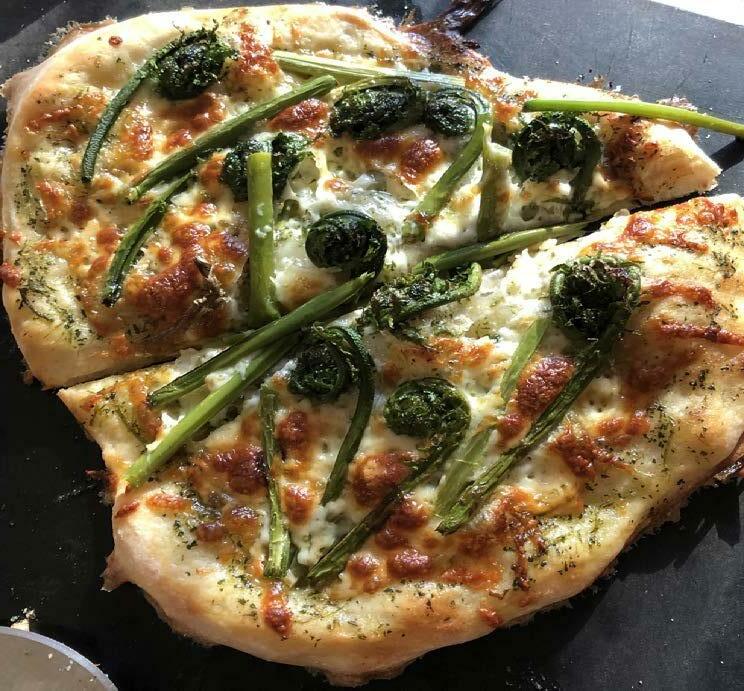
Foraging and making things like pickled mushrooms runs in Andy’s family. He learned from his dad, who learned from Andy’s grandfather, a Russian immigrant. Today, Andy and his partner Nora harvest and craft wild salads, pesto, lasagnas and cook wild greens with maple syrup and vinegar for themselves and their three kids who are 2, 6 and 11.
“I discovered the joy of gathering things—a childlike joy—and that kids will eat wild vegetables that they harvested themselves,” he says.
From March through May of 2020, he and his partner Nora Novich foraged enough wild greens, roots and shoots that they did not need any storebought produce. Foragers are able to sync up with a hyper-seasonal way of eating. Flushes of greens, packed with nutrients, welcome spring and then wean us off of fresh foods in fall.
“In spring I eat tons of tender greens,” he says, “then I move into tougher cooking greens. I am observing nature and looking for the first leaves of each plant.”
Our tour party travels by foot for three hours winding off-trail through woodlands and prairies. We stumble upon berries the birds have not discovered yet and black walnuts dismissively walked over by our fellow park visitors. After hammering the walnuts open on the sidewalk, we bite into the fleshy nut and receive a rush of flavor that is bittersweet, earthy and smooth. We sample tiny ornamental crab apples—condensed pops of fresh, juicy tartness.
I reach as far as my arms can extend to grasp hackberries from a tree nicknamed the “hamburger tree” for its ability to keep stranded hikers sustained on its berries alone for weeks.¹ With a four-foot long shovel we dig up primrose and wild parsnip. We chew purple thistle as gum. Back on the trail, we stoop to pick sochan leaves (cutleaf coneflower), a Cherokee food similar to spinach that is high in Vitamin C and folic acid.² It grows abundantly here at Lake County Farm Park and in the UW Arboretum.
The flavors we uncover are brighter and more complex than anything in a grocery store—at times intensely bitter, other times spicy and herbal. Similar to the unique flavors we uncover, Andy keeps revealing nuggets of wisdom. Plantains dot lawns in the summer—and were traditionally used for treating bee stings. Behind Edgewood High School are serviceberries, a berry so nutrient-dense it’s sought by bears prior to their hibernation. He says cow parsnip’s greens and stalks are sought by French chefs to make soups and borscht. Andy describes it
as a cross between celery and fennel, but 40 times better. Its flower heads are used to make fritters. My favorite are the wild carrot gems at the root of Queen Anne’s Lace and the wild parsnips growing abundantly in Madison parks. Both are prolific, and easy to identify and incorporate into meals for first-time foragers—and packed with stronger flavor than their cultivated counterparts.
We learn about the plants that have grown wild here for generations— including those indigenous to North America and those brought here by European colonizers. We see our

Crab apples are easy to find throughout our region.

history reflected in the plants—European descendants gone wild in an American countryside with abundant fertility. Indigenous plants and people squeezed by development, disease and animosity—given new, Anglican names.
Foraging seems to operate on a different timescale. You can’t be in a rush, you can’t expect to find what you are looking for, and oftentimes you find something even better than what you seek. It is like a scavenger hunt where you look for something edible, crack it open and unearth new joy and flavor inside.
Andy’s advice for newbies is: choose one or two plants you want to incorporate into your diet and learn how to identify them. Similarly, he recommends learning poisonous plants or families to avoid, like hemlock and nightshade. To learn where to go and the best times, connect with foragers in your area on Facebook Groups or sign up for a guided foraging tour. Understanding what areas are sprayed is important so you don’t accidentally ingest chemicals.
Foraging for fruit, nuts, mushrooms and invasive species (including watercress) is allowed in most Wisconsin State Parks. He sees foraging as beneficial not only for people, but land management as well.
“Foraging, as I see it, also involves tending to the places where I’m finding these plants,” says Andy. “I try to make sure the place is okay with that.”
Never pick too much of one thing, so others may also enjoy it and so the plant can truly thrive.
Chokecherries grow in clusters and are ripe in mid-late August. > Ramps appear in the spring in wet forested areas and along stream banks. >
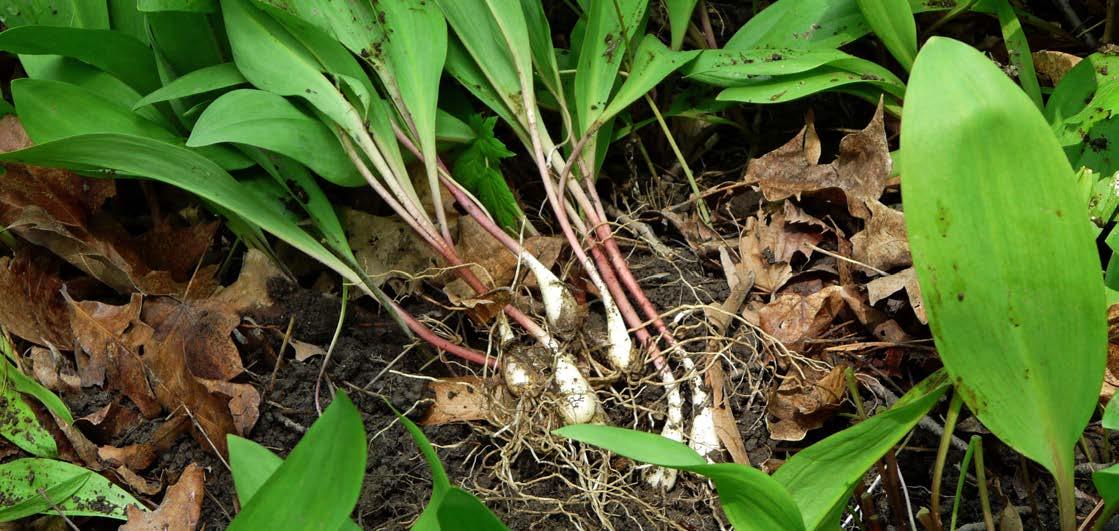

“There’s so much stuff to forage and it’s tied to ancestral knowledge, movement, nutrition and medicine. The non-human world needs us. We’re part of it and have effects on it whether or not we realize that. We need to find ways to engage with it that are mutually beneficial.”


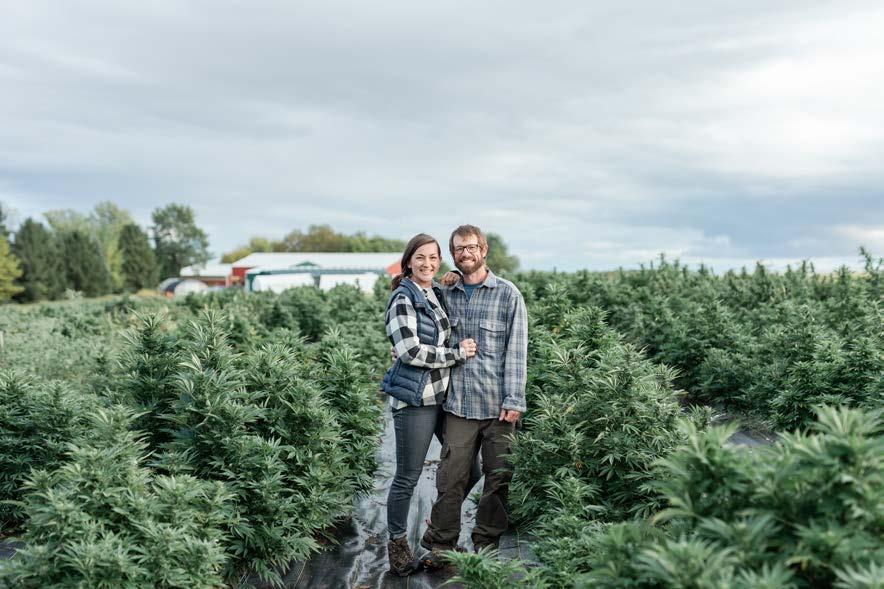

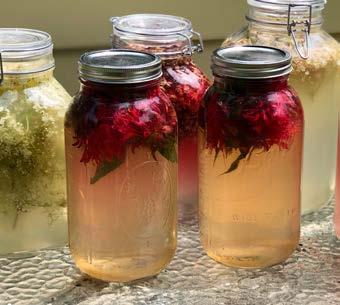

What Got Gathered offers a wild greens CSA from March to May and sells fermented
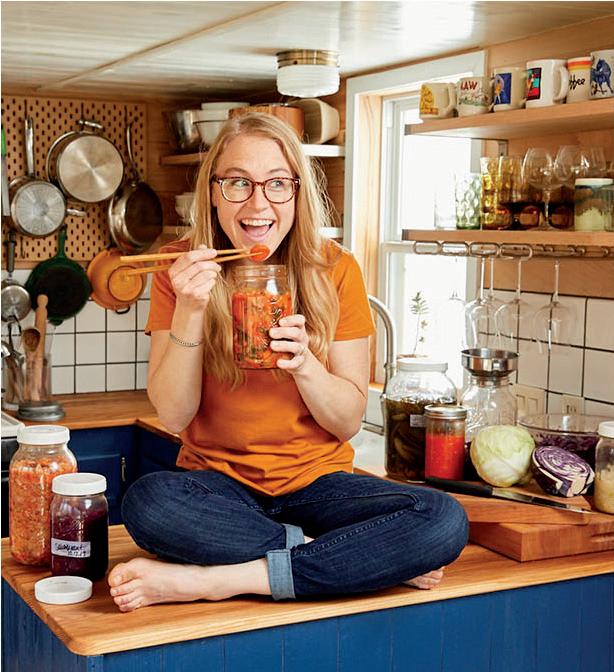
kimchi and spicy jellies at the Monroe Street Farmers’ Market Sundays May through
Private, socially distanced three-hour foraging tours are $40 per person. Kids welcome. Forage tour locations include Lake Farm County

Start your foraging journey by reading books, joining Facebook groups and following foragers on Instagram. Here are a few ideas to get you started:
The Forager’s Harvest written by Sam Farr of Bruce, Wisconsin


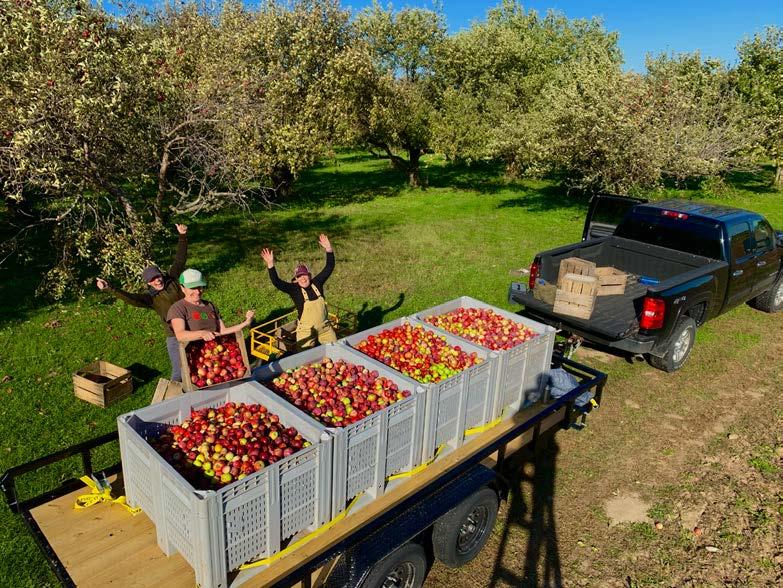
Midwest Foraging: 115 Wild and Flavorful Edibles from Burdock to Wild Peach by Lisa M. Rose
Facebook groups: Madison Wild Foods Collective; Wild Food Wisconsin and Upper Midwest Wild Edibles and Forager Society (northern Iowa); Upper Midwest Mushroom Identification Group
Midwest Forage Association www.midwestforage.org


Pick stinging nettle leaves. “It’s incomparable when small and tender, and has a seafood-y nutritional blast. It doesn’t get stingy until it’s bigger, and it’s easy to find and identify, both incredibly nutritious and delicious.”

Dig up roots. “The parsnips from previous year will be at their sweetest.” Note that foliage from parsnips can cause skin sensitivity especially when exposed to the light. Troutlily corms are also edible.

Seek the cutleaf coneflower, also called sochan. “The tender first spring growth of sochan is one of my favorites – its stem is carrot-y, mild and sweet.” Look for communities of plants in prairies and at the edge of woods.

Dig for winter cress. “A sometimes bitter, peppery prairie plant. Find it under snow when temperatures are consistently above 30 degrees. It will give you a nutritional rush.”

Prior to COVID-19, Andy and his partner Nora hosted What Got Gathered dinners in a friend’s backyard and at Common Ground in Middleton. One dessert brought tears to Andy’s eyes: toasted black walnuts in syrup. Try it on ice cream, or—even better—on cheesecake, with blueberries or wild berries of any kind on top. It may bring tears to your eyes too.
Serves 8-10
Prep time: 20 min
Cook time: 15 min
1 cup chopped black walnuts
1 cup maple syrup
4 tablespoons butter
1/4 teaspoon salt
1/2 teaspoon vanilla
1. Toast walnuts in a dry cast-iron skillet, stirring very often so they don’t burn, until they turn a shade darker and smell good. Remove from pan.
2. Bring syrup and butter to a boil in a small saucepan. Add salt and walnuts and stir. Boil for a few minutes, stirring frequently, until the sauce thickens a little. Remove from heat and stir in vanilla. Serve immediately, or store in a glass container in the fridge.

Adjust quantity and proportions to your needs and taste. Black walnuts have an amazing, intense flavor. Not everyone loves them, but we adore them for their rich flavor, tinged with blueberry. They’re leagues above the English walnuts you can buy at the store—and they’re all around us. You can often find small caches the squirrels haven’t entirely devoured at the end of the winter, just as we come into maple syrup season.
We hull our wild walnuts by rolling them around on a hard, flat surface under our boots. Then we wash them to get as much gunky stuff off the shells as possible, before letting them dry in a squirrel-safe spot for at least a couple of weeks. We have found the best and speediest method for getting the nuts out is just to whack them a handful of times with a claw hammer, not worrying too much about trying to get whole halves and quarters—just make sure no tiny bits of shell get in there. Twenty or thirty minutes of cracking should give you enough for a recipe—or you can order them, already processed, online, from local sources.
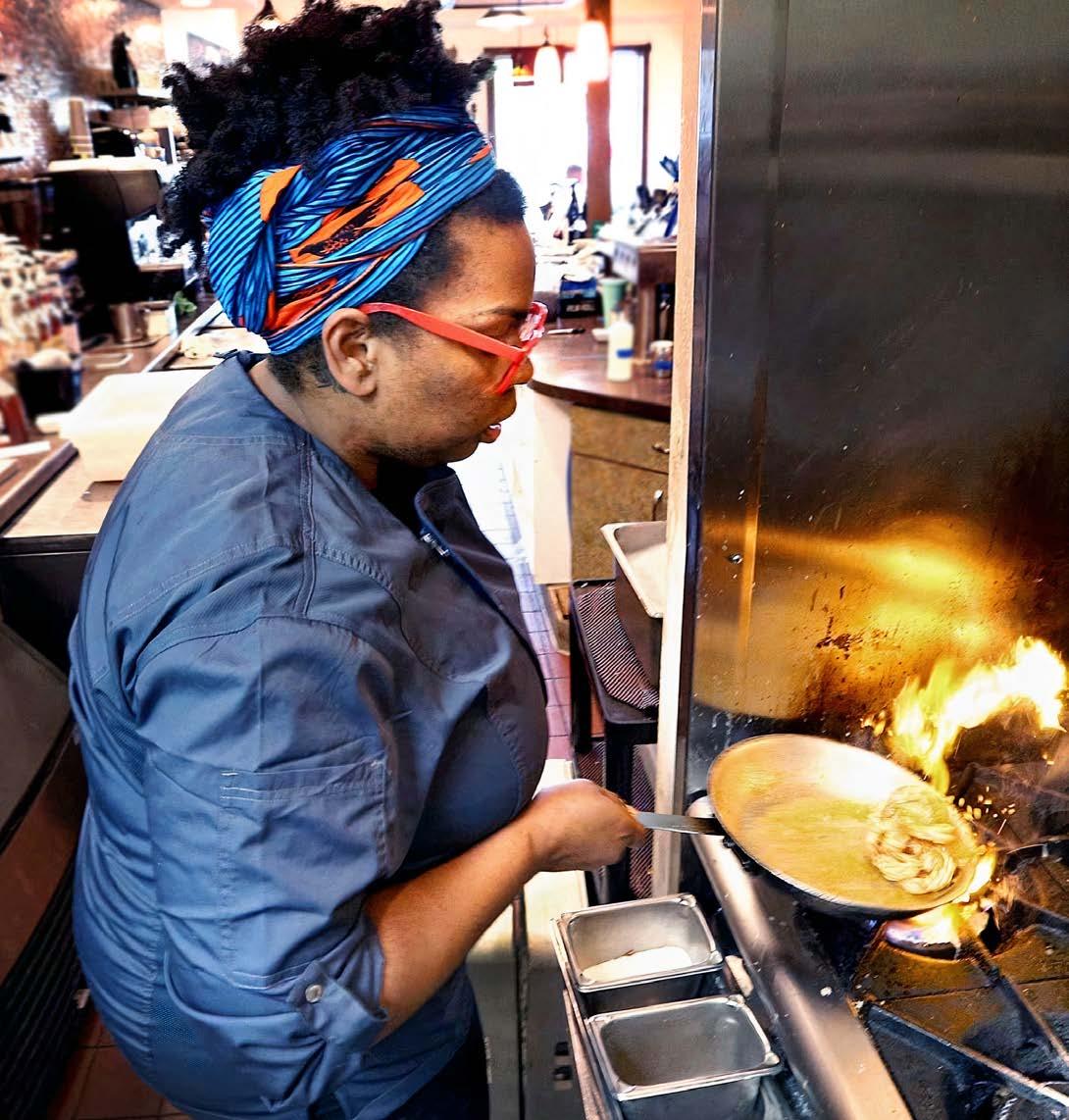 by Candice Wagener
by Candice Wagener
No matter how you say it, we’ve all done it this past year. For independent restaurant owners, being agile in their business has been critical to survival, even if that means hanging on by a thread. As a result, we’re seeing innovation in service models and products, and getting to know our favorite chefs just a bit more.
For an empath like Dave Heide, the chef and owner behind New Orleans-style, fine dining establishment Liliana’s in Fitchburg, his immediate reaction to the shutdown was strategizing how to support all the other people affected by his business. “My biggest worry was our little small mom and pop farmers,” says Heide, indicating farms that sell exclusively to restaurants. He knew those farmers were about to harvest produce like bitter lemons and celeriac—items unknown to many household cooks—and had a significant population of animals ready for slaughter. So he developed the Nom Nom Nom Kits, partnering with chefs like Tory Miller and Jamie Hoang. The kits contain farm fresh ingredients to make a gourmet dish, along with recipe and video tutorials. In 2020, the boxes put $78,000 back into the local farm economy.

Heide is planning to reintroduce the kits this June through October, during Wisconsin’s peak season. Until then, he implores diners to continue doing takeout for just a bit longer. “Liliana’s survived because Madison stepped up and supported us when they saw what I was doing in the community,” says Heide. “But restaurants have used up everything we have left.”

We are literally on fumes right now. —DAVE HEIDEPhoto by Tracy Harris
In La Crosse, Adrian Lipscombe has been using this time to reimagine her definition of the restaurant industry and community. Lipscombe is the owner and chef of Uptowne Cafe & Bakery, a Southern-American spot with subtle Midwestern influences. She also has a background in community planning, propelling her to convert to a takeout-only model before the shutdown was even official.

Over the holidays, Lipscombe and her staff experimented with shipping some of their baked goods and confections nationally, after a sweet potato butter rum cake she created went viral on social media. The adaptation was a success, so the cafe will continue to ship a limited supply of goods indefinitely.
Lipscombe also recently had the opportunity to teach virtual cooking classes in partnership with Pasture & Plenty, which she intends to continue in the new year. Not only does she get to live out her childhood dream of emulating Julia Child, but she also appreciates getting to know customers on a deeper level and vice versa.
Lipscombe wholeheartedly believes in trying things at the risk of making mistakes. “We have to keep moving forward, with the understanding that if you’re wanting to keep your business open, you have to change and adapt to what’s happening at this moment.”
We have to keep moving forward.
For Joan and Richard Neeno, the pandemic has been a reckoning of sorts, pushing them to explore new concepts. The Neenos broke onto the Janesville dining scene in 2017 with Lark, a fine dining restaurant located along the banks of the Rock River. Right before COVID hit, they were in the midst of renovating the space upstairs for events, and thinking about opening two new restaurants in a building they owned down the street. They quickly converted half of that space into Lark Market, a gourmet grocery with specialty cheeses, dips, sauces and desserts. They also incorporated take-andbake meals into the mix. Based on the initial success and continued concerns over the pandemic, they’ve shelved the pizza/pasta concept initially planned for that space in order to keep Lark Market going.
At Lark, they’re debuting a sandwich menu through spring, which they’ll carry over to their newest restaurant opening in April: Sandwich Bar. The spot will be modeled after the artsy vibe of Turkey and the Wolf, a James Beard award winning sandwich shop in NOLA. There’s already a mural in the works of Anthony Bourdain and Julia Child, painted by a local artist. Neeno says Lark will go back to “being Lark” at that time, hopeful that dining out will see a resurgence by May.

While we’re all eager for the pandemic to be a historical reference, no one can predict what that future will look like. But we know the restaurant industry will be permanently changed. For the establishments that adapt and survive, the connections and experiences will be more meaningful and diverse as many have found new ways to share their love of good food with a larger audience, and there really is a silver lining in that.

The next few months are going to be scary—I’m not going to lie about it….At least now we have coping mechanisms that we didn’t have a year ago.
–JOAN NEENO
As a partner at both Tipsy Cow locations and partner and chef at iconic Lombardino’s, Patrick O’Halloran has “been in the kitchen at the cutting board for twenty straight years.”
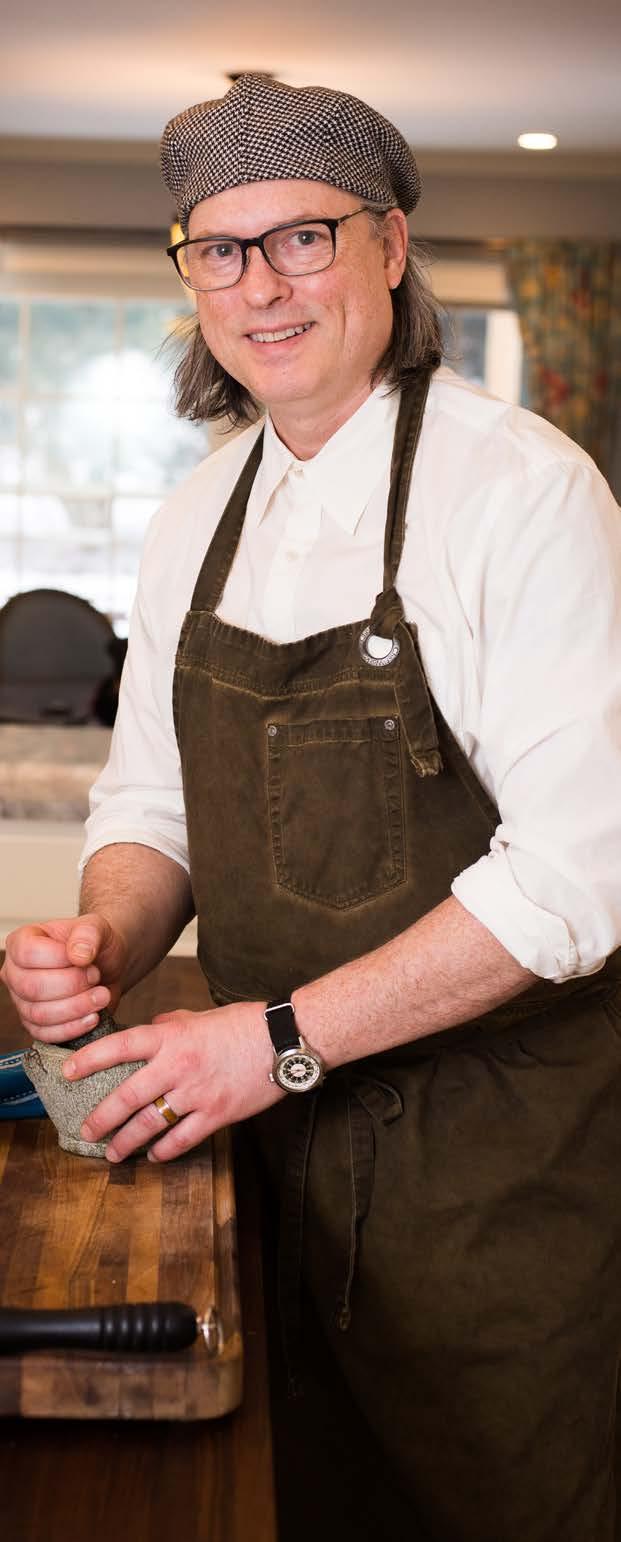
“I hadn’t done a lot of home cooking because the restaurant’s just a demanding way of life,” says O’Halloran, adding that the shutdown provided him the opportunity to do just that with his wife Michelle.
They started experimenting with dried spices in an effort to evoke travel memories, and created a series of YouTube cooking tutorials. The spices took off, and they brought on Patrick’s ex-wife, Marcia Castro (co-owner of The Old Fashioned) and their daughter Lucy, plus Michelle’s future daughter-in-law, Anne, for a truly original family business, launching The Deliciouser.
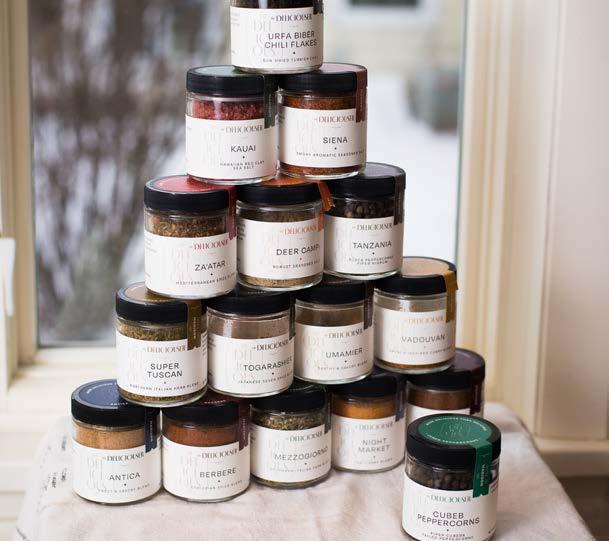
The Deliciouser blends all have a story, shared on the sleekly designed labels embellishing simple, yet practical jars with openings wide enough for tablespoons (or your fingers). Creations like Thai Night Market transport you to distant locales, with ingredients like coconut cream, lemongrass, fish sauce, and kaffir lime.
They’re developing a new blend for Valentine’s Day, and teasing the idea of single ingredient spices, like paprika from Spain smoked over live oak fires. Plans to expand their production capabilities are in the works (they are doing everything by hand in the basement of Bunky’s).
Despite the continued challenges posed by the pandemic, O’Halloran is optimistic about The Deliciouser. “I hope this can go somewhere. Part of why I was drawn to cooking in the first place is because food really connects you to people.”

Recipe from Patrick O’Halloran of The Deliciouser
This recipe uses a three step restaurant style of cooking. We start by seasoning and searing in a pan then a quick roast in a hot oven finishing with a brown butter baste. I like to serve the salmon with spicy roasted baby bok choy and a swirl of a simple Hart-Beet mayonnaise.
Serves 2:
Prep time: 20 minutes
Cook time: 15–20 minutes
Two 6-oz filets of salmon, skin removed
1 tablespoon olive oil
2 tablespoons cold unsalted butter
2 heads baby bok choy
1 tablespoon olive oil
Coarse salt
Freshly ground black pepper Morita smoked-chili flakes
½ cup mayonnaise, we like Duke’s or Japanese Kewpie brand
½ teaspoon Hart-Beet seasoned salt, plus extra for salmon.
Preheat oven to 400 degrees F. Arrange your oven racks so you have room to roast both the bok choy and the salmon.
For the bok choy
1. Slice the heads of bok choy in half, season the cut side with a drizzle of the olive oil, salt, pepper and Morita chili flakes.
2. Place the bok choy cut side down on a sheet pan and roast in the oven for 12–15 minutes while you prepare the salmon. Ideally the bok choy should be tender with crisp outer leaves and become slightly caramelized on the cut side.
For the sauce
3. Mix mayonnaise and Hart-Beet seasoned salt thoroughly. The color will bloom and intensify as it rests.
For the salmon
4. Season the salmon liberally on all sides with Hart-Beet seasoned salt.
5. In a nonstick pan over medium heat add the olive oil and the salmon.
6. Raise the heat to high and sear for one minute undisturbed.
7. After one full minute flip the salmon and sear the second side for 30 seconds.
8. Place the pan with the salmon in the oven and roast for 3–5 minutes.
9. Remove the salmon from the oven and return to the stovetop over medium heat.
10. Add the cold butter to the pan.
11. As the cutter melts and begins to foam it will take on a nutty aroma. Using a large kitchen spoon, .baste the salmon for 30–45 seconds.
12. Remove the salmon from the skillet and serve.
I like to serve my salmon medium with a slightly opaque center, a few minutes more in the oven will take you to medium-well and eventually well-done before you move on to the basting step.
Hart-beet salt makes this dish shine and can be purchased from deliciouser.com, but you can also substitute sea salt .












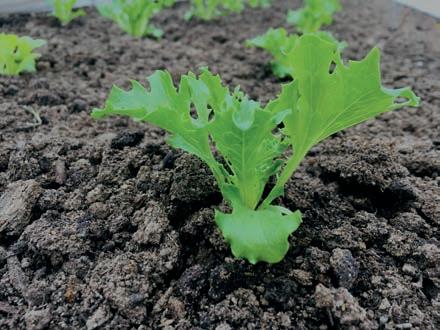
AUTHENTIC SUPERIOR
P.O. Box 24, Herbster 715-774-3849 authenticsuperior.com
THE GROVE MARKET 24 E. Main St, Evansville 608-882-1566 thegrovemarketllc.com
VIROQUA FOOD CO-OP 609 North Main St., Viroqua 608-637-7511 viroquafood.coop
WILLY STREET CO-OP
Willy East: 1221 Williamson St., Madison 608-251-6776
Willy West: 6825 University Ave., Middleton 608-284-7800
Willy North: 2817 N. Sherman Ave., Madison 608-709-5445 willystreet.coop
BOOKKEEPING WITH COMMON CENTS 608-498-0292 bookkeepingwithcommoncents.com
HEARTLAND CREDIT UNION heartlandcu.org
KAREN INNIS Century 21 Affiliate 608-799-1338
MG&E
623 Railroad St, Madison mge.com/sharedsolar2021
Please support the following businesses to experience the best local, seasonal, and sustainable products and services in the region.
WELLNESS
KOSA SPA
3241 Garver Green, Suite 260, Madison 608-999-7558 kosaspa.com
LAURA POE MATHES viroquanutritioncounseling.com
FARMS & FOOD GOODS
CIRCADIAN ORGANICS circadianorganics@gmail.com circadianorganics.com
FARM FRESH CANOLA OIL
1349 Greenway Rd, Marshall info@farmfreshoil.com farmfreshoil.com
RALEIGH’S HILLSIDE HEMP
901 N. Marsh Rd, Brodhead raleighshillsidehemp@gmail.com wilocalhemp.com
WESTRIDGE PRODUCE 26820 Kasts Ln, Blue River westridgefarmers@gmail.com westridgeorganicfarm.com
FOOD, AGRICULTURAL & SUSTAINABILITY ORGANIZATIONS
COOK IT FORWARD cookitforwardmadison.com
FAIRSHARE CSA COALITION
303 S. Paterson St., Ste. 1B, Madison 608-226-0300 csacoalition.org
REAP FOOD GROUP
306 E. Wilson St., Ste. 2E, Madison 608-310-7836 reapfoodgroup.org
SLOW FOOD-MADISON slowfoodmadison.org
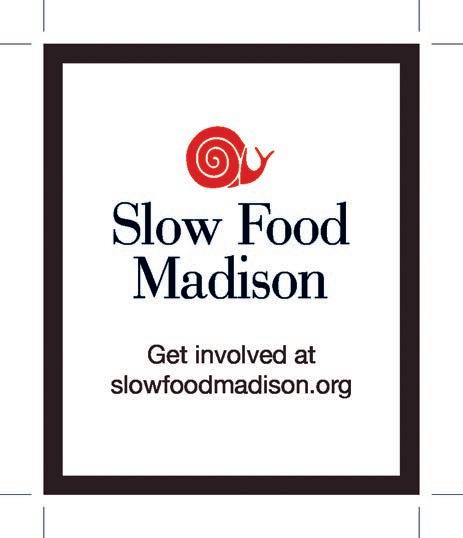
SUSTAIN DANE
211 S. Paterson St., #200, Madison 608-819-0689 sustaindane.org
VALLEY STEWARDSHIP NETWORK 124½ South Main St., Viroqua 608-637-3615 kickapoovsn.org
FOOD & BEVERAGE
BRIX CIDER
119 S 2nd Street 608-437-2749 brixcider.org
EMMI ROTH CHEESE 657 2nd St., Monroe rothcheese.com
FROMAGINATION
12 N. Carroll St, Madison 608-255-2430 fromagination.com
GIANT JONES BREWING COMPANY 931 E Main Street, Madison giantjones.com
ISLAND ORCHARD CIDER 12040 Garrett Bay Rd., Ellison Bay 920-854-3344 islandorchardcider.com
MADISON SOURDOUGH 916 Williamson Street, Madison 608.442.8009 madisonsourdough.com
ORIGIN BREADS
931 E. Main Street, #1, Madison 608.381.2125 madisonsourdough.com
PASTURE AND PLENTY 2433 Old University Avenue Madison 608-665-3770 pastureandplenty.com
RUDE BREW KOMBUCHA 1219 Sherman Ave, Suite 7153, Madison 608-354-5064 rudebrewkombucha.com
TELSAAN TEA 209 E. Main St F, Mount Horeb telsaan.com
WONDERSTATE COFFEE
1201 North Main St., Viroqua 608-637-2022 wonderstatecoffee.com

Explore a world of local food through the magazines and websites of Edible Communities. We’ll introduce you to the chefs, farmers, brewers, home cooks and others who inspire and sustain local flavors across the US and Canada.

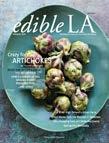

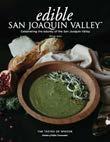

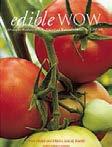















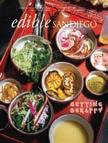


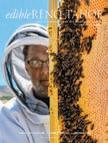
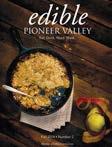










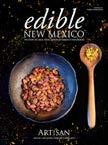











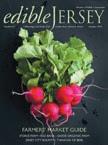






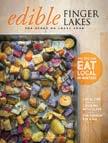


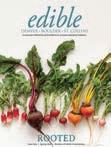


















“For the first time since we started Vitruvian ten years ago, it feels like we have not slowed down even a pinch during winter. Normally we slim down to about one team member or so to help keep the farm going through winter (along with help from myself and Tommy), but this year we have almost five fulltime staff members going strong!
The COVID pandemic pushed us out of our comfort zone and pressured us to try something we have been thinking about for a long time—home delivery. Now that we have made this leap, and because we have gotten so much positive feedback from our community, we’re inspired to keep pushing the limits of what we do. Microgreens have been an offering from the beginning, and it’s inspiring that our business is growing as quickly as these sprouts.”
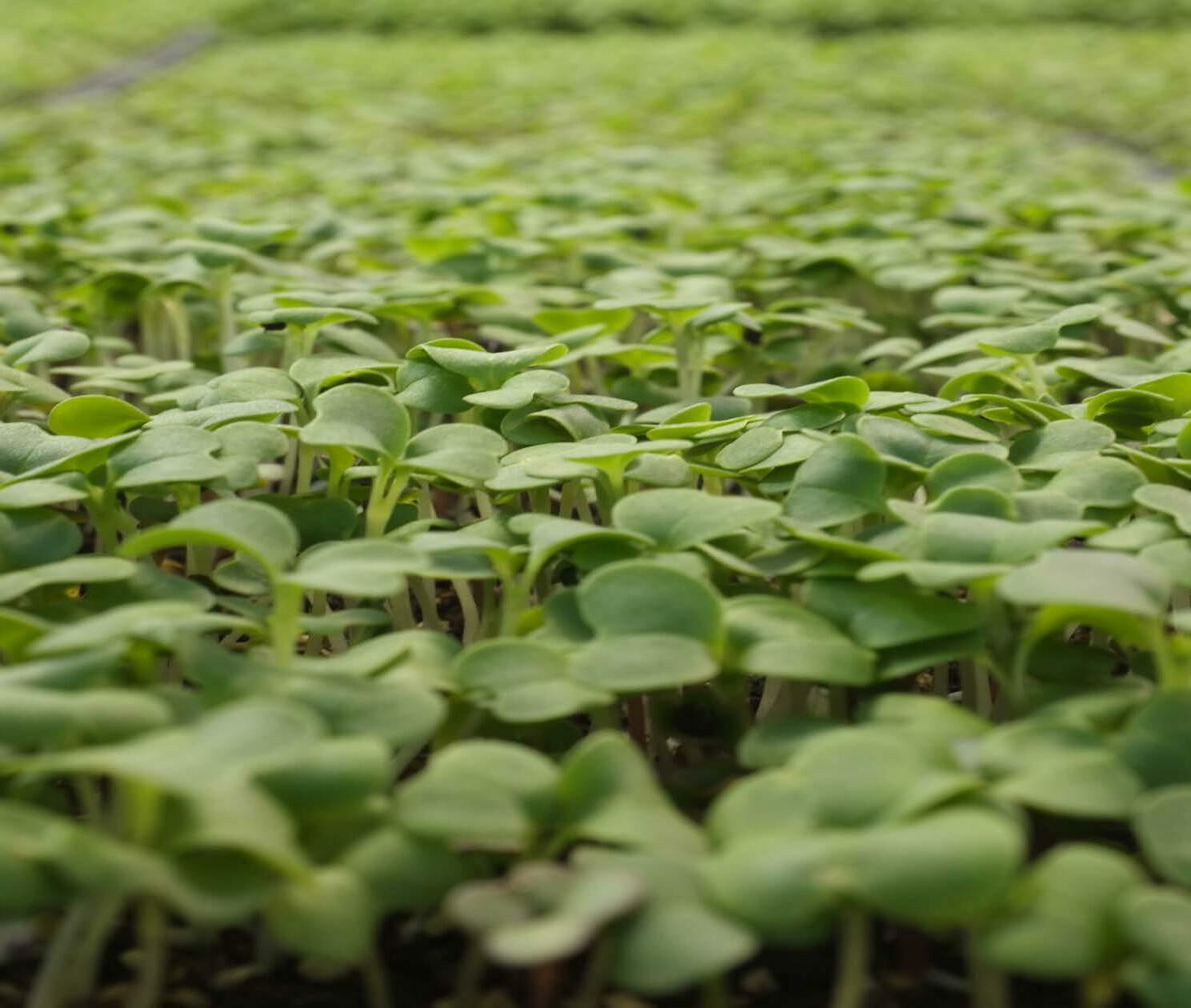 - Shawn Kuhn, Partner Vitruvian, Town of Dunn
- Shawn Kuhn, Partner Vitruvian, Town of Dunn